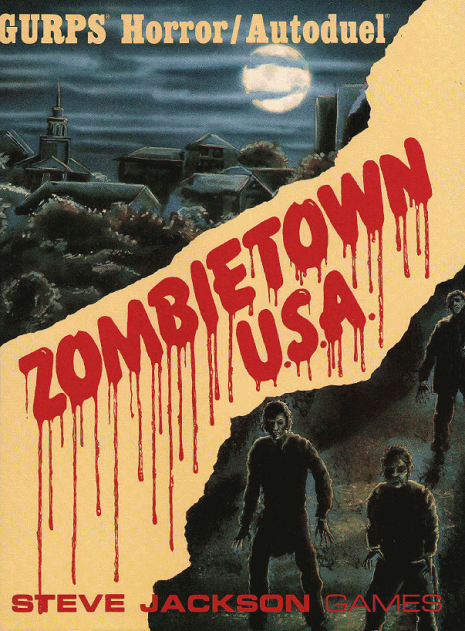GURPS Fantasy II: Adventures in the Mad Lands by Falconier111
THE LAND
Original SA postGURPS, as far as I’m aware, has a reputation for being so flexible and universal it becomes impossible to play in. You can represent truly anything with it – I’ve made functional mystical gunslingers, insane psychics, muscle wizards, and tons of regular idiots that all work in the system; however, since it lacks any real hooks, unless you want to run something you’ll never find anywhere else, it’s best to look elsewhere. Published GURPS settings, therefore, sometimes came out looking as weird as possible to snag that demographic. GURPS Fantasy II is an example of that philosophy, as well as how it failed; the common consensus on the intertubes is you can’t run a campaign in such a narrow, fixed world. They’re right. Sort of. While I can’t argue that the setting is
real
hard to explain to players without giving them homework, I think the setting’s a lot more intuitive than people give it credit for and the important elements can be explained – and campaign ideas generated – with little energy or time spent. I aim to show you how.
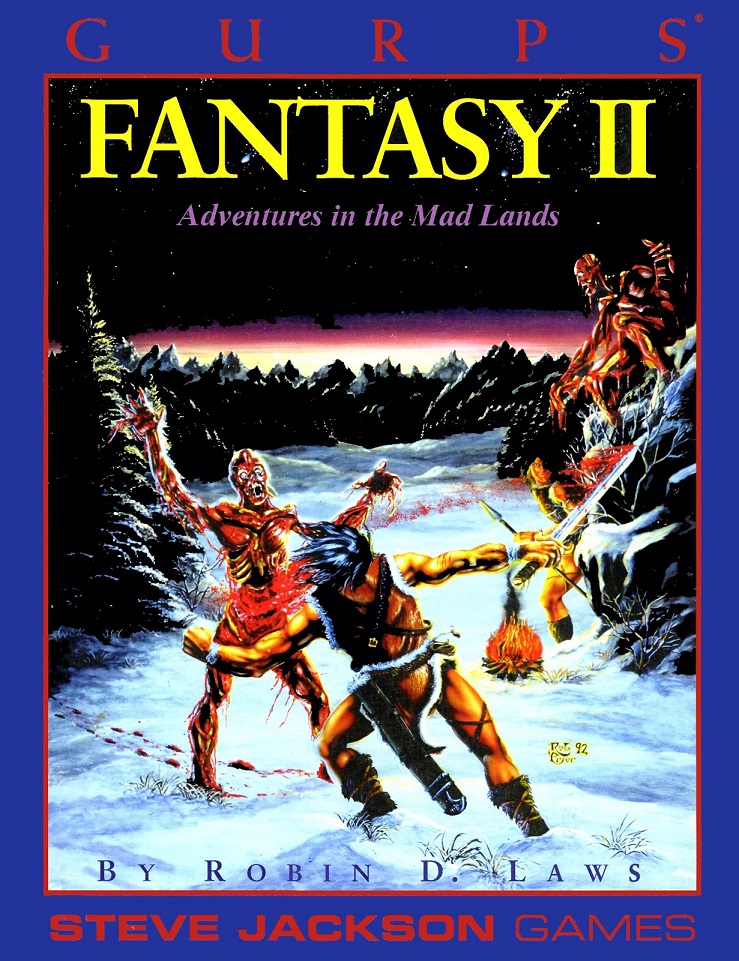
Format wise, the book is laid out with a large column down the center of each page and a smaller column down the side (usually elaborating on a topic mentioned in the main text). It’s worth noting here that this book was written for GURPS 3rd Edition, while mechanically I’m only familiar with 4th; if we do get to making characters, I’ll use the rules I’m familiar with and kludge the info in this book together with my prior knowledge. All 3rd ed books use this format, including Reign of Steel (
thank you for doing it that setting is baller
), so if you see any misplaced text in a badly-taken snapshot, that’s probably why. Most pages have a picture on them somewhere, livening up the twin walls of text considerably.
The introduction is short, just 1 page long. It talks about how the Madlands suck, gods are crazy, community is important, etc. etc. The most important take away is summed up in this paragraph;
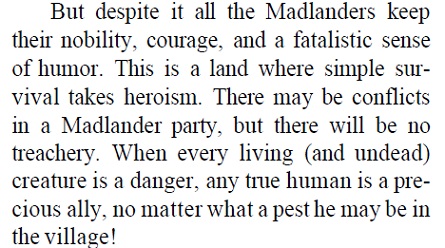
Madlanders are stuck in a shitty situation, but they’ve dealt with it all their lives and want nothing more. The community is the most important thing to these people and they’ll do anything to protect it. And herein lies the problem of roleplaying in this setting; people who enjoy playing murderhobos are unlikely to get into the struggles of a small tribal community right away. I hold that explaining everything in this setting is unnecessary at the beginning, but at least getting your players on board with playing ordinary people is something you need before even beginning to plan the game.
1 – THE LAND
The book starts out by describing the terrain in surprisingly modern terms. The Madlands are a small, cold continent underlain by igneous rock with a little bit of soil on top; some parts in the more inhospitable regions have all kinds of quartz. Glaciers have ranged over the land countless times, leaving fjords (described as “the fingers of an arthritic giant) and several strange landscape features including rocks hanging off cliffs (curiously, it doesn’t talk about the shorelines, which are very important to the setting). However, much of the Madlands owe their shape to a force much stranger – the gods.
In most settings, the supernatural is beyond the ken of ordinary mortals, with gods mysterious and distant figures that can be beseeched for power, whether or not it’s a good idea. Here, the gods are not only actively wandering the earth but so crazy sensible Madlanders always,
always
fear and avoid them. They regularly warp the landscape by hopping, digging, or just fucking with local physics, and everything strange and unusual in the region can probably be traced back to them – or to one of the magical creatures spawned by the special properties of the continent, all of which are destructive. Everything supernatural in the Madlands is ill-omened at best and probably actively malevolent; good Madlander hate and fear magic, spirits, and gods of any kind, usually for good reason.
For instance, while the stars in the rest of this world behave like ours do, in the Madlands they move around and flip you off. That’s not much of an exaggeration;
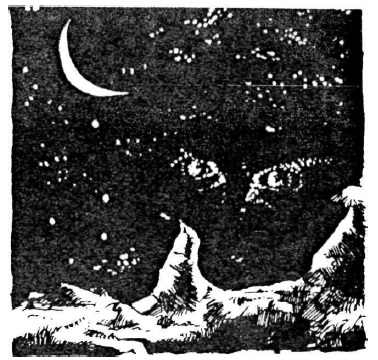
While normally they just fuck around, sometimes the stars form a shape – always a bad omen. There’s a lot of bad omens in this setting. It’s worth noting that the stars go back to normal once you go out to sea, so people can sail to and from here without
too
much trouble.
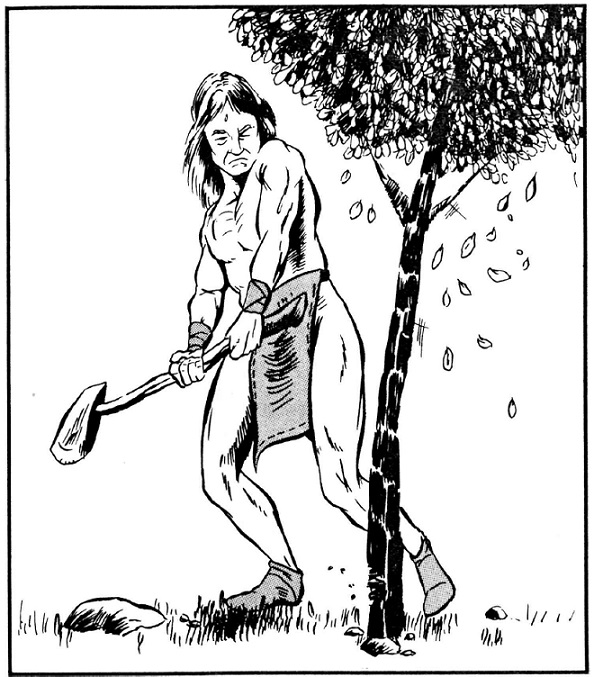
Naturally, weather is as nuts as everything else here. Winter is punishingly cold and somehow also humid; spring is sudden, widely variable in temperature, and causes floods and heavy rain, washing away valuable soil; summer is actually pretty okay (75 degree average temp, violent thunderstorms, and occasional heatwaves) and reminds me of where I live; and autumn is short, miserable, wet, cold, and ends suddenly with a plunge into the depths of winter. Flora isn’t too notable (we’ll get to fauna later) but tubers are important to the locals (who, by the way, live almost entirely in fishing/farming/hunting villages on the coast; the interior’s only inhabited by horrible outcasts). You can make these plants into everything from spices to staple foods to nasty alcohol.
However, there’s more to the world than just this place. Four other cultures surround the Madlands, and Madlanders consider all of them of them crazy. Their denizens sometimes drop in to trade, explore, or get horribly murdered by local wildlife.
TOGETH
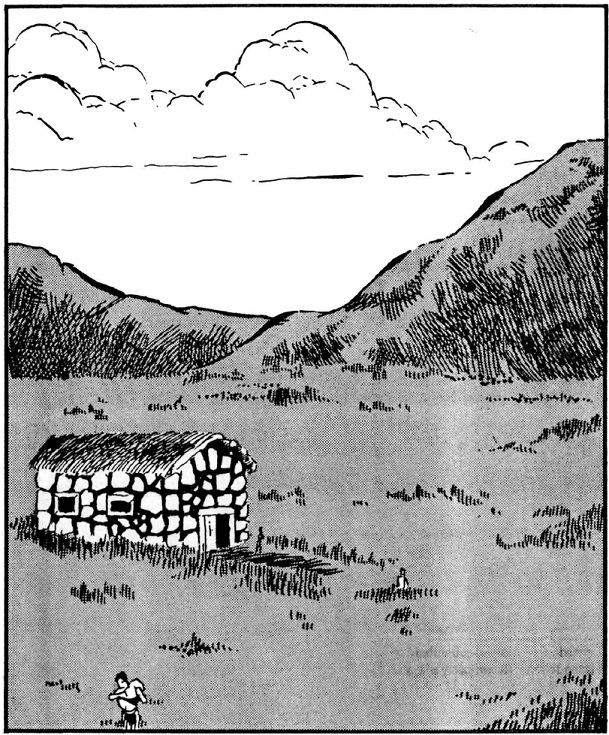
Togeth is your dirt-standard fantasy setting. Togethians used to be raiding bastards so horrible they were driving themselves extinct, but culture hero/first king Srideen figured this out and tried to stop tribal warfare by conquering everybody. This failed and killed almost everybody. Next he prayed to the local god, also called Togeth, who promptly and unexpectedly turned rocky, inhospitable Togeth into a fertile basin, ordered Srideen to repopulate it, and fucked off.
Modern Togeth is fantasy-style bland – knights and peasants, middle class growing, powerful families ruling the government, everybody worshiping Togeth, etc. etc. etc. However, their adventuring knights see the Madlands as a great place to adventure and kill things for glory. Madlanders, having no concept of history (we’ll get to this later), see the Togethians as the vicious raiders they once were and kill them on sight; in return, Togethians believe Madlanders insane savages and return the favor. Don’t be a Togethian lost in the Madlands.
THE WHITENESS
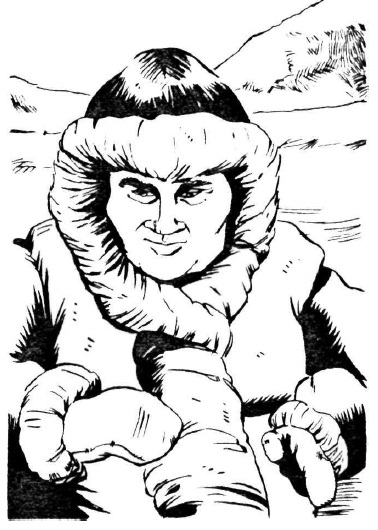
The north pole, inhabited by
Inuit
Sap Cid. The snow up here is sentient (
 ) and the Sap Cid deal with it as a deity with multiple conflicting avatars (intelligent clumps of snow). Living in small ocean mammal-hunting bands, they have a complex system of taboos, morality, egalitarianism, and mutual obligations that ties them together; however, tensions do exist and sometimes boil over;
) and the Sap Cid deal with it as a deity with multiple conflicting avatars (intelligent clumps of snow). Living in small ocean mammal-hunting bands, they have a complex system of taboos, morality, egalitarianism, and mutual obligations that ties them together; however, tensions do exist and sometimes boil over;
“GURPS FANTASY II” posted:
On the rare occasions when warfare does involve actual harm, it becomes very bloody indeed.
They do enter the Madlands sometimes, but only to trade their dried berries, blubber, and ivory for iron tools, booze, and weapons. Madlanders find the Sap Cid pleasant enough for foreigners, and their accent, word choice, and demeanor are considered hilarious and they think the cold has fucked up their minds (the Madlanders call them Viwti E – “Frozen-brains” – which I assume is a lot more cutting in Madlander
 ). Their most interesting hook is that they hunt seals, which are of human-level intelligence in this world; seals often try to turn Madlanders and Sap Cid against each other for revenge or just for funsies.
). Their most interesting hook is that they hunt seals, which are of human-level intelligence in this world; seals often try to turn Madlanders and Sap Cid against each other for revenge or just for funsies.
NORTHERN TRIBELANDS
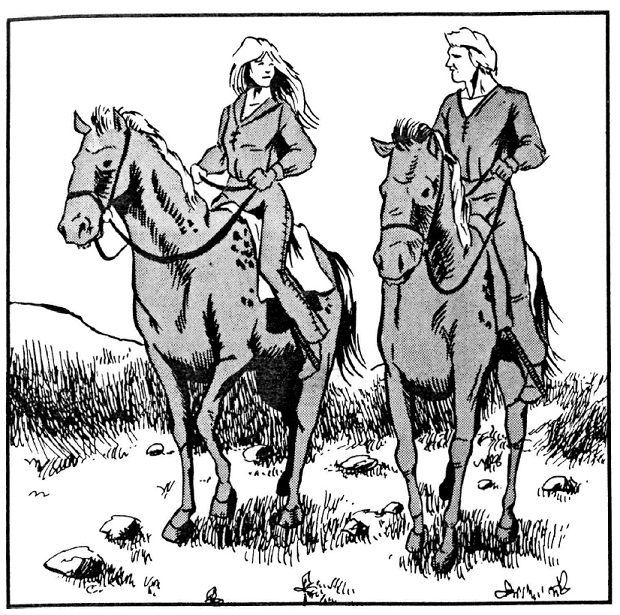
These guys suck. They’re an entire culture of Mary Sues who ~ seek out their own destinies ~ and ~ live in peace with their guardian spirits and nature itself ~ . They barely have a society at all; instead, every Tribelander is born with a mission or quest they have to fulfill before they die. What sort of quest? Good question! If they fail, they’ll just reincarnate with a different spirit and mission. Nobody cares what you do otherwise in Tribelander society unless it’s really, really vile, in which case you’re either exiled or executed. Tribelanders come to the Madlands looking for spell components and to perform their various quests, but they hate it as much as perfect wonderful Mary Sues can hate anything; the supernatural weirdness interferes with their spirit guides and even the slightest hint of associating with spirits gets them murdered by a terrified Madlander mob. Otherwise, all Tribelanders are peaceful and friendly and accepting and spiritual and

SAVARGINIA
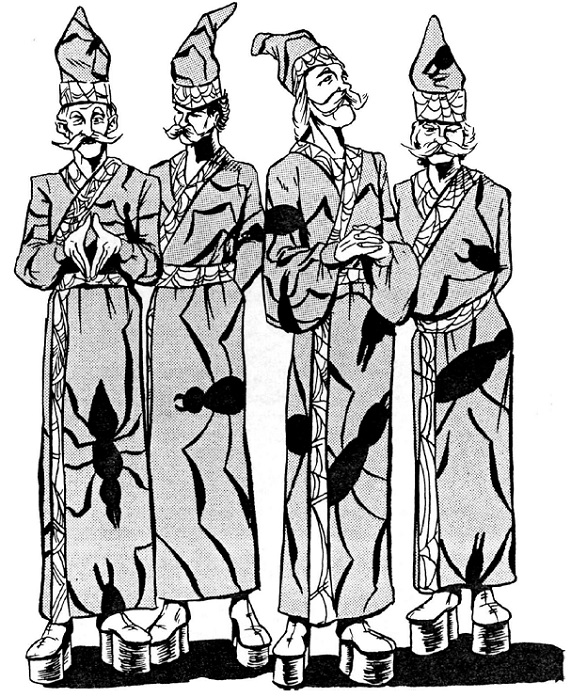
An entire society of FUCKING WIZARDS specifically designed to be a society of FUCKING WIZARDS. Long, long ago, two wizards got bored of, quote, “smashing planets and turning gods into paperweights” (presumably in 3.5
 ) so they decided to make their own setting, with mutant bat chess and hooker cities. The result was Savarginia, a collection of city-states so
MAGICAL
that occasionally a city is obliterated and replaced with an even weirder one without fanfare due to
MAGIC
. Savarginians love entertainment, novelty, and any kind of
MAGIC
, which they positively bleed from their pores (naturally pissing off Madlanders who find out); however, since the cities all so
random
, every conceivable rule about Savarginia is broken by some of its inhabitants. The authors kindly include a list of the current major city-states of Savarginia to give you an idea what this strange, strange place looks like;
) so they decided to make their own setting, with mutant bat chess and hooker cities. The result was Savarginia, a collection of city-states so
MAGICAL
that occasionally a city is obliterated and replaced with an even weirder one without fanfare due to
MAGIC
. Savarginians love entertainment, novelty, and any kind of
MAGIC
, which they positively bleed from their pores (naturally pissing off Madlanders who find out); however, since the cities all so
random
, every conceivable rule about Savarginia is broken by some of its inhabitants. The authors kindly include a list of the current major city-states of Savarginia to give you an idea what this strange, strange place looks like;
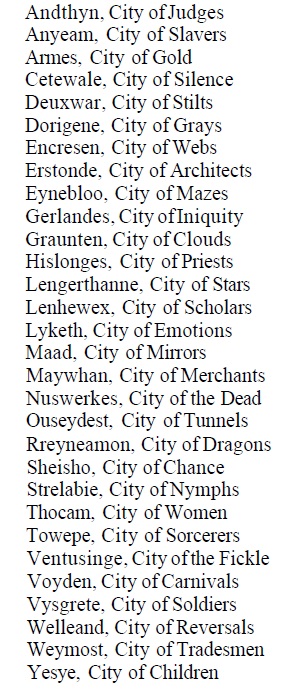
Spot the Oscar Wilde reference! Also, Yesye

Savarginians are so completely confident in the superiority of their civilization that they get gibbed pretty often when they visit. Madlanders consider them even crazier than most foreigners, largely because they have so little in common with each other and you can’t predict what they’re going to do; they do trade with them sometimes, but even the slightest hint of something out of the ordinary will get a Savarginian killed. This doesn’t prevent them from coming, however, because nobody gets to tell a Savarginian they have a bad idea
 .
.
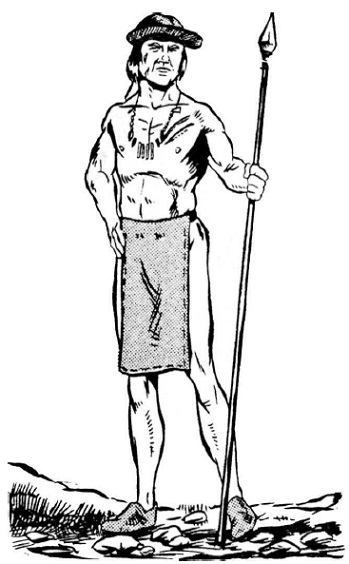
The chapter wraps up by discussing how to insert this setting into other settings – relatively boring stuff. Finally, it points out that Madlanders only have a limited conception of the outside world; to them, you’re either a human being living here, or a strange foreigner from somewhere else.
THOUGHTS: So far, there isn’t much to process here. The terrain analysis of the land is useful but can be explained to players entirely through narration, while foreigners make interesting plot hooks sometimes but can be excised from a campaign entirely. The same can’t be said for the next section.
Next time: Folk tales, crab fishing, and a surprising lack of transphobia for a book published in 1992!
MADLANDER CULTURE
Original SA post 2 – MADLANDER CULTURE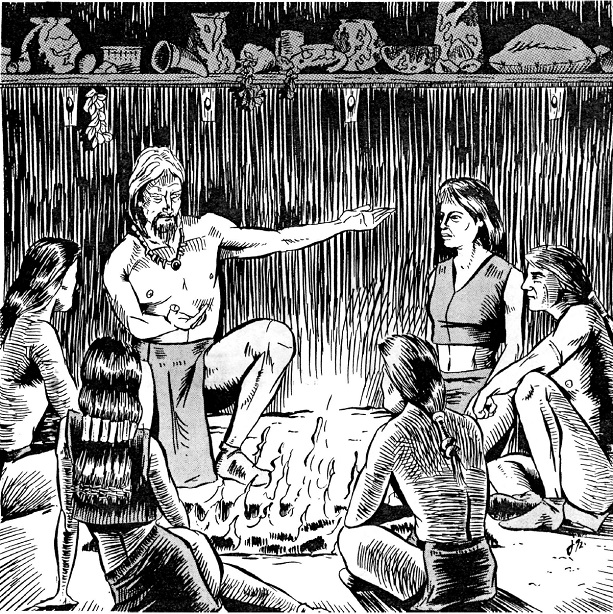
Hey baby, do my weird wink and uneven nipples turn you on?
As far as material needs go, the Madlanders have it pretty easy; though extracting a living from the surrounding land is hard, there’s enough to allow them enough time for art and recreation. However, they have to deal with the prospect of supernatural disaster at any time. Madlander culture is shaped around surviving both the land and its magic.
In a Madlander village, men do the hunting and fishing and women do the farming (which consists entirely of food or medicine tubers). Women also make everything except iron tools, weapons, and buildings, but both genders make a “pungent” kind of booze known as zoxibek. Everything made is shared by the community, though people do get to use specific items they particularly like; basically, you can take any item you want as long as the “owner” doesn’t object, and if you can argue to a neutral arbitrating party that you using something would help the community more, you get it anyway. As for things made outside the village, Madlanders avoid relying on foreign goods for anything to keep away from getting dependent on them. However, they happily trade for luxury items or unusual foods. By the way, Madlanders live in and identify with their villages; though they do help each other when they can, there’s no sense of nationality and every village fends for itself.
Game Idea 8 : A foreign trader (probably Savarginian) is trying to set up a trade route with your village, and several elders have become enamored of their goods. How will you convince them to give up their treasured items for the sake of the community? Or, will you protect the trade route and try to build your village into something greater?
Game Idea 9 : A villager, the friend of one or more PCs, is growing too attached to his spear and is refusing to give it up. Several villagers think his greed is attracting supernatural attention, and they’ve charged the characters to convince him to part with it. Why is he so set on keeping it? Does it have anything to do with his recently dead wife? And does it have anything to do with how his most fervent opponents are his dead wife’s parents?
It’s worth noting here that the book’s depiction of village life is problematic in a few ways. First, there’s the obvious issue of gender; men and women lead very different lives that are somewhat defined by Western gender roles. Though it goes out of its way to point out how the genders do have balanced power – women are equal to men as elders, both sides have important roles in running and supplying the settlement, and as for those who wish to assume another gender role, well… we’ll get to that later.
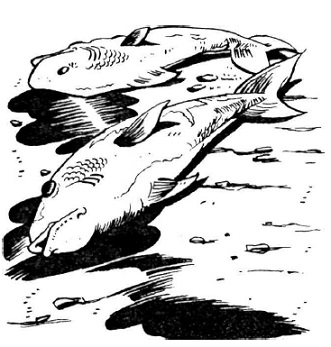
Don't worry, be gutted and eaten by anti-magic barbarians!
The primary division in Madlander society (which is between men
 ) is fishers and hunters. Though everybody goes on both hunting and fishing expeditions at the appropriate time of year, most men identify with one group or the other and heartily mock their counterparts when they come with them – only for the favor to be returned later on. Speaking of which, humor is important to both sides (we’ll elaborate on that later); choice nicknames for fishers include “cod slayers”, “trail farters”, and “skunk attractors”, which are countered with stuff like “whale bait”, “sinkers”, and my personal favorite, “boat painters”. The book points out that these jokes actually serve a purpose; they diffuse anxiety on expeditions by reinforcing their “manhood” (“I may be shit at this, but at least I can give as good as I get!”), making them more confident. Also, it gets them riled up and competitive, making everyone work harder.
) is fishers and hunters. Though everybody goes on both hunting and fishing expeditions at the appropriate time of year, most men identify with one group or the other and heartily mock their counterparts when they come with them – only for the favor to be returned later on. Speaking of which, humor is important to both sides (we’ll elaborate on that later); choice nicknames for fishers include “cod slayers”, “trail farters”, and “skunk attractors”, which are countered with stuff like “whale bait”, “sinkers”, and my personal favorite, “boat painters”. The book points out that these jokes actually serve a purpose; they diffuse anxiety on expeditions by reinforcing their “manhood” (“I may be shit at this, but at least I can give as good as I get!”), making them more confident. Also, it gets them riled up and competitive, making everyone work harder.
Game Idea 10 : The PCs are a group of fishermen sent in with a hunting party only to encounter a heightless (basically an invulnerable serial killer with an Achilles heel, see later). As their more knowledgeable companions are picked off, can the PCs figure out the monster’s weakness in time to survive?
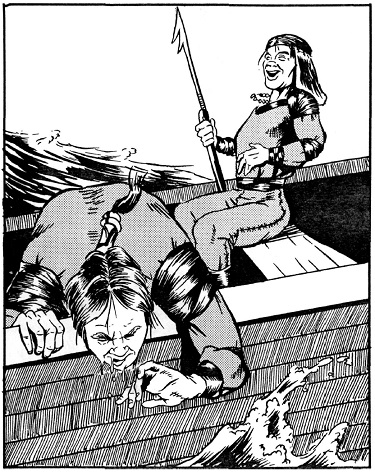
Vomit is always charmingly depicted in tabletop games.
Speaking of humor (and language in general), the book goes out of its way to talk about Madlander jokes. The Madlands are fucking awful, and humor is one of the best ways to deal with fucking awful things. Such jokes tend to be super duper dark – the example given involves a guy getting all four limbs and his head bloodily torn off – but they don’t see it that way; instead, all the violence and destruction inherent in these jokes make the ineffable less scary. The same goes for proverbs; Madlanders love proverbs, trotting them out every time it seems even vaguely appropriate. They even use proverbs that no one understands anymore! They just use them whenever something weird happens and they don’t know what to say.
Game Idea 11 : This is more suitable for downtime in a Madlands campaign than a game. . The characters are sitting around a campfire at night when they decide to start busting out old jokes. Have the players come up with the darkest jokes they can think of, tell weird proverbs, and mildly insult each other for maybe 45 minutes.
Also, instead of swearing with words for excrement or particularly blaspheming (a fucking terrible idea), Madlanders use words with social meanings – stupid, lazy, drunk, etc. “Useless” and “liar” are both grave insults, and calling someone a Gaget (lit. Togethian) is fighting words. Racism! There isn’t much else to talk about here.
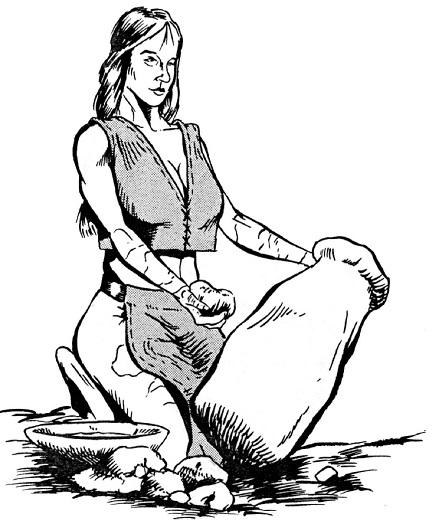
Pottery in the Madlands is made by jamming wet rocks into giant hunks of meat.
But there’s plenty to talk about here! We’ve finally hit the timebomb that’s been ticking since I started writing this – gender. According to the book, Madlanders see women and men as fundamentally different but fundamentally equal. It doesn’t avoid western gender roles, though; those are woven into the book deep . The sexes divide labor according to gender, as mentioned above, and work interaction between them is scarce – most intersex relations are between family, relatives, and spouses rather than friendships. Women are more intelligent and complex than those silly, simple men
 and invent most new jokes and proverbs, which are then refined by the men into “hoary chestnuts”. As such, men find women strange and mysterious
and invent most new jokes and proverbs, which are then refined by the men into “hoary chestnuts”. As such, men find women strange and mysterious
 and mostly pursue the most mystifying ones. In return, women tend to condescend to men because they think they know them so much better than they know themselves (am I right, ladies
and mostly pursue the most mystifying ones. In return, women tend to condescend to men because they think they know them so much better than they know themselves (am I right, ladies
 ) and find their bravado cute and amusing, like a small child saying they’re a grownup. It then spends a couple paragraphs describing ideal appearances for both sexes, which are basically modern ones
) and find their bravado cute and amusing, like a small child saying they’re a grownup. It then spends a couple paragraphs describing ideal appearances for both sexes, which are basically modern ones
 . This book goes so far to present women as equal to men that it ends up coming out coming out sexist in its own way, putting women on a pedestal and stereotyping them into mysterious temptresses. If I were to throw out any section of the book, this would be it; just rule that women can become hunters/fishers too, but they have to deal with a male-dominant culture.
. This book goes so far to present women as equal to men that it ends up coming out coming out sexist in its own way, putting women on a pedestal and stereotyping them into mysterious temptresses. If I were to throw out any section of the book, this would be it; just rule that women can become hunters/fishers too, but they have to deal with a male-dominant culture.
Sexual mores are covered here, and surprisingly they’re done pretty well. Basically, Madlanders understand the mechanism behind childbirth and such but don’t attach any concept of sin to fuckin’. In addition, you’re allowed to do whatever you want as long as it’s consensual, up to and including adultery (though Madlanders mate for life, they don’t mind extramarital relations as long as they’re discrete). So there’s that.
Game Idea 12: Two villagers are cheating on their spouses. In and of itself this isn’t much of a problem, but every time they slip off together something bad happens in the village – someone falls over without provocation and sprains their ankle, an entire wavobek burns its meals, an elder spontaneously develops an illness, etc. Can the players find out who’s behind this recent string of bad luck? Who’s cursing the lovers; a malevolent force outside the village, or a malevolent force inside it?
But then comes my favorite part of this chapter, squirreled away in a sidebar on the gender comparison page. Sometimes, transgender people (though they’re not called by that name) show up in the community, and society has a way to handle that. After convincing the village council they’re genuinely dedicated to switching sexes (which is implied to be both pretty easy and reliable for evaluating seriousness), they make a little announcement to the village meeting, put on different-gendered clothing, and that’s it. At that point, they’re treated as part of the other sex in all ways, not just economic but social as well – generally they take wives of their former gender. There are no homosexual marriages in Madlander society, though, so elders generally don’t allow married people to switch genders – unless the partner also wants to switch! This is specifically pointed out in the book. For a book written in 1992, it’s a little surprising to find this here.
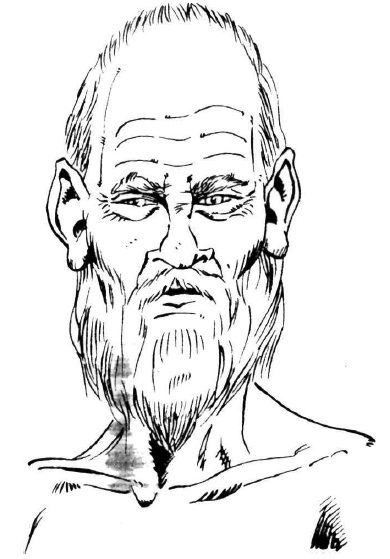
A typical Madlander elder/mutated elf. It isn't an actual elf, though; those are way worse.
The focus of Madlander life is the community, though they all respect other Madlanders to some degree. Everyone is expected to offer their distant relatives shelter and comfort, of course, but the village comes first. After the village comes the clans, which number around 11-13 per village and 50-75 members; they live in wavobeks (Native American longhouses) and each have an elder that represents it on the village council. Elders are hugely important; they have absolute say over all clan matters and decide issues on the village council (though of course they have to keep the interests of the clan in mind). They also settle disputes, either for their clan if the dispute involves only clan members or as a neutral party in an interclan dispute. The decisions they make are binding, but can be appealed to the village council; however, such an action is considered “unseemly” and rarely gets you anywhere. Afterwards, elders try to gently persuade everyone involved to accept the decision, after which comes a coordinated, organized teasing campaign (see Madlander humor). If that fails and people are being particularly ornery about things, a tribunal can be called by any three adults; those exonerated go free and might be able to call a tribunal on their accusers at elder discretion; otherwise, they’re either given an opportunity to reform or just exiled. Exile is horrible – no madlander will ever treat an exile as anything other than a monster. The worst offenders will be tied to a tree and left for the monsters.
Game Idea 13: A villager convicted of burning fishing boats for fun was tied to a tree and left for the monsters. However, small fires have been found burning across the settlement – and one was spotted springing from nothing! Obviously, the criminal has become a shaman (a god-worshipper and spellcaster) and is trying to destroy the village. Can the players find and stop him? Or is there another force using him as a dupe?
Age, no matter the gender or circumstances, is the ultimate source of respect and authority in Madlander society. It’s the only qualification for becoming an elder, after all! Respect for the aged runs so deep that old people are fed before children and pregnant women in times of famine (why would you do that
 ) and an entire village will risk life and limb to protect them. Some old folks question this position and try to convince their neighbors otherwise, and this is taken as proof of their wisdom, of course. Others are lucky idiots who abuse their station and lead their clans to ruin. However, skill and great deeds can also make a person important and respected, especially epic achievements and skill levels that no one else could achieve (the book gives no examples of great deeds). Pure rhetorical skill also gives people influence in the village, and provides an opening for characters with no outstanding traits to get involved in village politics.
) and an entire village will risk life and limb to protect them. Some old folks question this position and try to convince their neighbors otherwise, and this is taken as proof of their wisdom, of course. Others are lucky idiots who abuse their station and lead their clans to ruin. However, skill and great deeds can also make a person important and respected, especially epic achievements and skill levels that no one else could achieve (the book gives no examples of great deeds). Pure rhetorical skill also gives people influence in the village, and provides an opening for characters with no outstanding traits to get involved in village politics.
Game Idea 14 : A clan elder has gone crazy; not the supernatural kind, mind, but the kind where she starts accusing villagers of things they couldn’t have done and insists on taking them to the tribunal, over and over and over and over again. One of the PCs is accused of theft and she won’t leave them alone. Can the party convince either her, her clan, or the village council to leave them alone? Or are her repetitive accusations forming a ritual, leading to dire consequences?
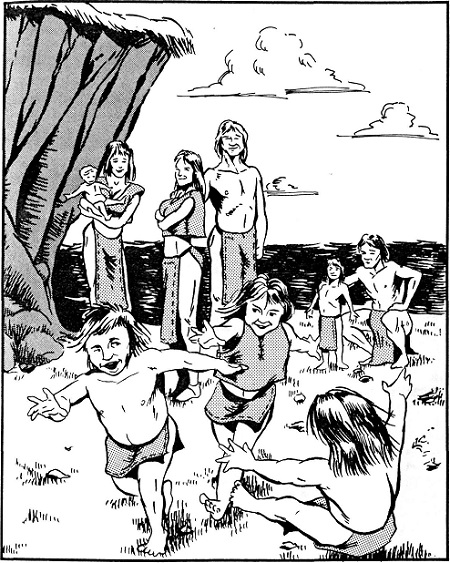
Somebody fucked up, 'cause that kid's obviously a mutant.
The vast majority of cultures have formal ceremonies to celebrate life stages, holidays, and important events. Madlanders hate that shit because it draws the attention of the gods – and doing that is basically suicide. Instead, they have informal events at important points in a person’s life, such as the procedures following birth, where if a child is deformed or looks supernatural in anyway their head is bashed open by the clan elder on the rocks
 . Otherwise, a child is named and considered fully human until it uses magic. Then it stops being human.
. Otherwise, a child is named and considered fully human until it uses magic. Then it stops being human.
By the way, no Madlander is allowed to use the same name as anyone in the village in living memory (including the living) or they run the risk of possession.
Game Idea 15: A young child's naming is interrupted when a villager absent from the meeting realizes the child shares a name with her dead mother. With the help of that woman and the child's parents, can the PCs figure out if the dead woman's spirit is still around to haunt the village?
Other Madlander “rituals” are pretty standard; initiation to adulthood (new adults of both sexes are taken to the shore and dunked in the water), marriage (the new couple joins the wife’s clan) and death. Death is the most important transition in a Madlander’s life because they can come back from death if improperly disposed of; their hands and feet are lopped off, their eyes and mouth are sewn shut, and they’re either dumped at sea or cremated. No post-death procedure is done exactly the same way (to avoid creating a fixed ceremony) and their “possessions” are given to others to keep the dead from coming back to claim them. If anything goes wrong, or the dead person is just a dick, they’ll come back and haunt the village.
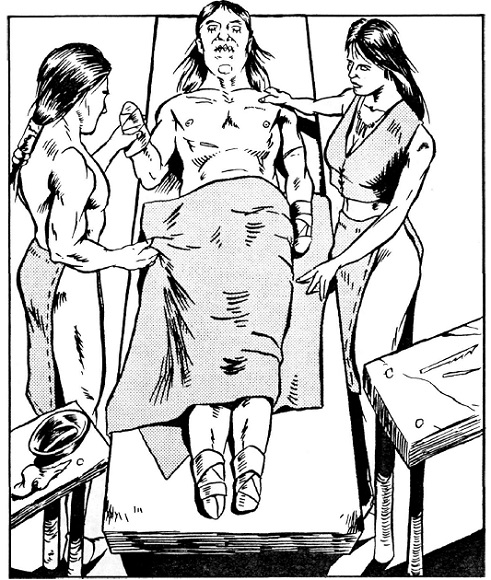
This review is child friendly!
Sidebars! Causation! Madlanders have two models of cause-and-effect. On land, everything happens for a reason because a supernatural force wants it that way. Good things are always caused by a negative spell failing, though there are so many hostile forces out there that identifying the cause of ordinary misfortune is impossible. Out at sea, everything happens at random ‘cause nothing supernatural can reach past the shoreline.
History! Madlanders don’t care about it. In fact, they actively avoid remembering their past since that shit attracts ghosts like you wouldn’t believe . Instead, they regard time as circular; everything before living memory is purposefully forgotten and attributed to legendary characters, most notably Zo Do Wabda or Vigidi (see later). They don’t care about creation myths or anything because they see speculation on the beginning of the world either pointless or dangerous.
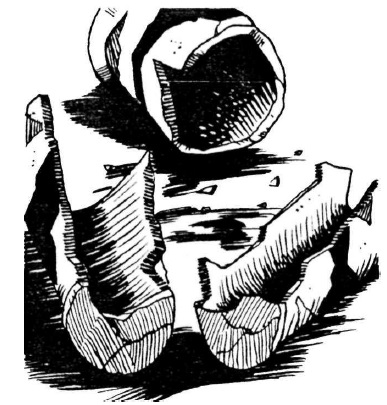
A housefly shaman on the other side of the continent sneezed and broke my pot!
Still, Madlanders love storytelling, and their favorite characters are Zo Do Wabda and his wife Vigidi (always referred to in that order in the book); they’re stock characters so broad it’s impossible to attribute anything to them individually. In this way, and since they represent no real people, Madlanders can get around ritual prohibition to tell stories. Generally, one of the pair is wise and the other is foolish, though often they’re both terribly stupid, and they always always suffer in some way for their stupidity. There are other stock characters in Madlander stories (such as children or unmarried adults), but they’re not elaborated on in the book.
The authors give a fucking long shaggy dog story about the two as an example. Basically, Zo Do Wabda dreams a god will kill him, and his confidence in that death allows him to escape several otherwise inescapable deadly situations. He then goes home to his wife and comes to the conclusion that his lack of fear (not the dream itself) is what saved him… only for the god in question to come around and kill him horribly. They also give guidelines for making up your own stories – Zo Do Wabda/Vigidi tales come in cautionary, heroic, and tragic flavors – and gives summaries of other typical stories – my favorite is “the haunted wavobek”, which is an account of an ordinary day for a clan that grows more and more eerie until the inhabitants kill a group of travelers one by one to adopt their ghosts into the clan.
Game Idea 16: A visiting storyteller’s tales seem eerily prescient; every time he tells a story, someone in the village ignores the moral and suffers from it. Who is causing these accidents; the storyteller, a rival, or a force using the storyteller as cover?
Game Idea 17: A talented young storyteller – a relative or friend of the PCs – has a mad idea; collect all the stories of the Madlands and spread them to all settlements. The players are dragged along in their mad quest as they brave monster, god, and distance to deliver stories to all who will listen.
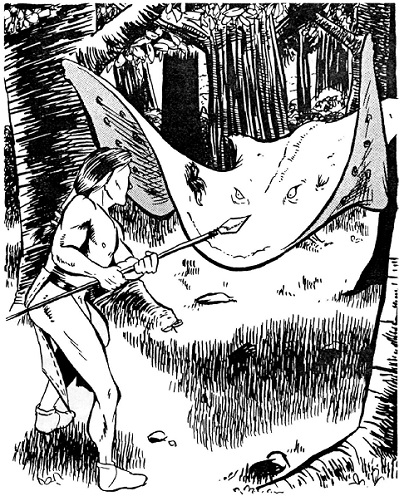
This thing used to be human. Can you spot the armpit hair?
Finally, there’s a page and a half on Madlander language. The book doesn’t lay out grammar or syntax or anything as unimportant as that; it just tells you what letters are present in Madlander speech (there’s a near-silent glottal stop represented in the text as a space in names), how to convert English words to Madlander-sounding equivalents (it involves find-and-replace), and how Madlander gesture language works (gesturing and body language are super important and carry almost as much meaning as spoken words). And then, finally, we’re done with this chapter.
THOUGHTS: This chapter must be well-kept gunpowder ‘cause this shit is dry . There’s a lot of interesting stuff in here, but the information is so densely presented it’s hard to hold it all in your head – not to mention how important so much of it is to the setting and how much doesn’t make sense without the context of later chapters. Had I designed it, I would have at least put the Gods section before this to give the reader an idea of what Madlanders fear, but I haven’t designed a game so I don’t have the right to criticize it
 . Still, most of what’s in here is suitable to be doled out to players when they get to the appropriate parts; of course, that requires a GM to memorize it all, so that might be hard. At the end of the day, this is the part that people complain about when they say
GURPS Fantasy II
is too hard to get into and understand, and I don’t really have an answer for that. Except, of course, to either acquire a working knowledge of the setting through experience, just wing it, or both.
. Still, most of what’s in here is suitable to be doled out to players when they get to the appropriate parts; of course, that requires a GM to memorize it all, so that might be hard. At the end of the day, this is the part that people complain about when they say
GURPS Fantasy II
is too hard to get into and understand, and I don’t really have an answer for that. Except, of course, to either acquire a working knowledge of the setting through experience, just wing it, or both.
GAME IDEAS: 17
Next Time: Schlip, schlap, you really can't go wrong, vith traditional fish-schlapping game!
FINALLY: I’d like to demonstrate how Madlander names and words work. If you folks wouldn’t mind supplying me with some names you’d like translated into Madlander, I’ll tell you how they’d turn out in Anti-Magical Barbarian.
Bonus Language Nonsense
Original SA postForwarning; these would probably be multiple words in Madlander, as its words are pretty short, but the book recommends a substitution method that produces long results.
Kavak;
1. Be Atkunbixbe Ek
2. Bigbizavebizibakode At
3. Bigdebtazgexuge
4. Botawtaxazdebxe Ewe
5. Bitawt Toxibeknebek
6. Bob Oxinwon
7. Botadbigkatank
8. Botvandezixuge
9. Bazibekaxazdede At
10. Bubeketankabixewt
11. Bukekedzinketotwa
12. Bukek Xazdbabek
13. Butubaxde Adtikt
14. Bixunkexe Ad
15. Bixunkeg
16. Buzudbonede At
17. Buzunbexbutatwete Ak
18. Dizekaxazdekeb
19. Kiwatzobkebone
20. Katink
21. Katintizonwetag
22. Kzidgetazgede At
23. Giziwtetedbatexoznibodga
24. Xabkatowkiwt
25. Xunk
26. Tudkebe Ekbezotux
27. Kunbexzobkagzoin
28. Kunbexwide Izon
29. Kunteke Edbuxunk
30. Ze Ekbatawtubodgo
31. Zotetkiztebe Ek
32. Zikewte Akukabe
33. Wutabobutkexe Ad
34. Wotabweku Atitexuzuwt
35. Wetad
36. Wetatekiwtebzunbex
37. Wetatewtabuzobki
38. Wadaw Xitadkaw
39. Wudokedanduwbete
40. Wiktintbexewtaxa Iz
41. Wetudkobe Ekiknob
42. Wetudkabxunkdan
43. Tuxibkedbizunkawt
44. To Ubixizuwtezod
45. Tuzunkwetadbixewt
46. Wixikwitagbuxe Ek
Correspond to
1. Beat PunchBeef
2. Big, Brave Brick of Meat
3. Big McLargeHuge
4. Blast HardCheese
5. Blast ThickNeck
6. Bob Johnson
7. Bold BigFlank
8. Bolt VanderHuge
9. Brick HardMeat
10. Buck PlankChest
11. Buff DrinkLots
12. Buff HardBack
13. Butch DeadLift
14. ChunkHead
15. Chunky
16. Crud BoneMeal
17. Crunch ButtSteak
18. Dirk HardPec
19. Fist RockBone
20. Flink
21. Flint IronStag
22. Fridge LargeMeat
23. Gristle McThornBody
24. Hack BlowFist
25. Hunk
26. Lump BeefBroth
27. Punch RockGroin
28. Punch Side-Iron
29. Punt SpeedChunk
30. Reef BlastBody
31. Roll Fizzlebeef
32. Rip SteakFace
33. Slab BulkHead
34. Slab SquatThrust
35. Slam
36. Slate Fistcrunch
37. Slate SlabRock
38. Smash LampJaw
39. Smoke ManMuscle
40. Splint ChestHair
41. Stump BeefKnob
42. Stump Chunkman
43. Thick McRunFast
44. Touch RustRod
45. Trunk SlamChest
46. Whip SlagCheek
Also
1. Moe Howard
2. Larry Fine
3. Curly Howard
4. Max Power
5. Johnny Murder
6. Ice Miller
7. Bartholomew Foxworthington
8. Bob Johnson
9. Adolf Hitler
10. Fluffy Weaselbeef
11. Gabriel Garcia Marquez.
to
1. Do Ezowatd
2. Tatatgepine
3. Butategzowated
4. Daxipowet
5. Oznangidutdet
6. Ibedititet
7. Batatezotodewpoxwotutezingaton
8. Boboznawon
9. Adotepzitatet
10. Petupupgewe Awetbe Ep
11. Gabetietgatbi Adatpu Ez
What a beautiful language

Also
Count Chocula posted:
If you want the incredibly specifc TORG scenario of 'interdemensional business tries to buy up Japan and tangles with the Yakuza' done right, read the manga Tekkon Kinkreet.
And that Madlander stuff sounds super-interesting.
Looking back at my writeup, I may have been so familiar with the book I found it repetitive instead of fascinating. I think it says something that I consider this the most boring chapter of the book (outside the character creation section).
DAILY LIFE
Original SA post GURPS FANTASY II3 – DAILY LIFE
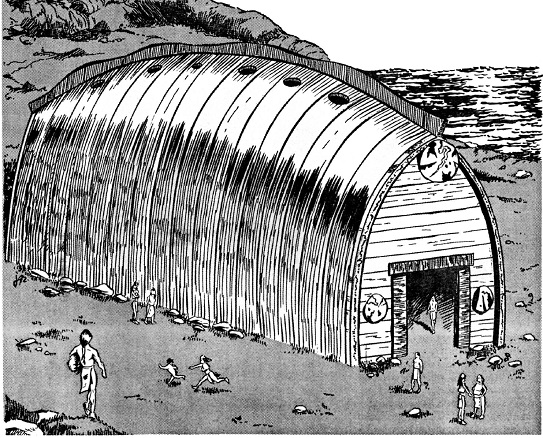
House for sale, upside down boat with cozy living spaces, fire pit, and hardrock floor, 1 room 50 bed 0 bath 36x18 sq. ft.
The characters are assumed to do a lot of hunting, so details are laid out here. All hunters go out in parties (easier not to get fucked sideways by the environment that way), usually about 2-3 hunters to 2-3 fishers (a perfect party size). The skills necessary to hunt are listed (exactly what you’d expect). Bears and dear are considered the best targets, but they’re not always available; small animals like squirrels and rabbits are also collected, as well as valuable medicinal herbs and occasionally lumber or iron ore. The wilderness is crawling with monsters, but encounters with them are actually rare and most hunters injuries and deaths are caused by mundane animals, especially bears; however, monster encounters are much more deadly and greatly feared. The same goes double for gods. Also, outlaws and exiles live in miserable camps in the interior and raid any hunting parties they come across, while deceptive geography and weather also kill their fair share of Madlanders every year.
Game Idea 17: A hunting party has encountered a group of outlaws desperate for weapons and food! Can the players outsmart the hardened criminals and destroy their camp, navigating past traps, ambushes, and dangerous wildlife?
Game Idea 18: A giant bear is threatening the village. The players are tasked with hunting it down and killing it, but must also face its enraged mate and near-mature offspring.
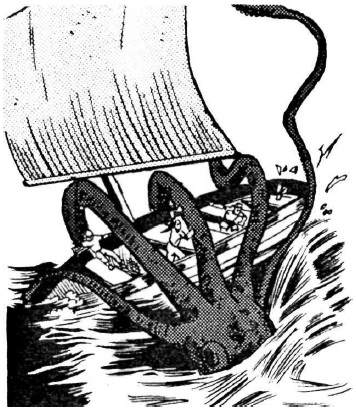
Aww, it just wants to cuddle

Fishing is the other main type of expedition, and though it lacks the supernatural bullshit that plagues the land it’s still plenty dangerous. Mostly, fishers go out in much larger crews – 15 to 20 people are common (I’m not sure how this would work with an average-sized party). There’s plenty of fish to be found during fishing season (when’s fishing season? Good question) as well as squid and crab. Crabs deserve special mention; crabbing boats are smaller and have a much easier time than their fishing-focused cousins, and hunters scramble to claim a position on them and avoid the more dangerous open water. And dangerous it is; though the water is actually warm enough to prevent hypothermia, drowning is a concern and storms are frequent and often devastating. Whales (mostly killer whales) are considered excellent prey but can wreck a boat or even a fleet; giant squid sometimes surface and behave exactly like you’d expect; seals, though nonviolent and civilized, will ruin catches and misdirect boats out of spite; and sometimes Savarginian pirates will raid the area for goods, food, and slaves.
Game Idea 19: A storm has swept your crabbing boat out to sea, into the shore of a mysterious island. Can your party, the mixed hunters and fishers who survived the wreck, find out where they landed and eke out survival?
Game Idea 20: Fishers have spotted a fleet of Savarginian pirates out at sea – and they’re heading for the village! The party must prepare their fleet for war, building warships, collecting weapons, and even calling on neighboring villages for help.
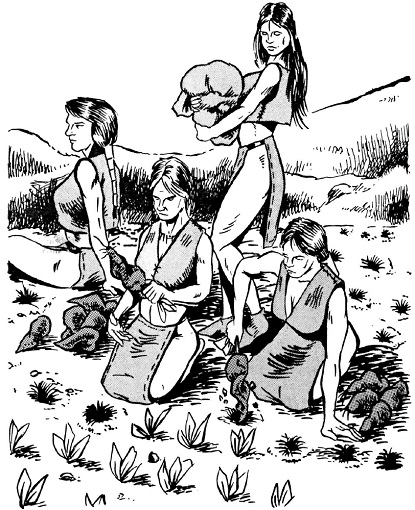
This may look like hard work in the field to feed their families, but these tubers are for booze makin’.
Food is a huge deal in the Madlands; pleasure needs to be found wherever it can, and food and drink serve that purpose admirably. Madlander food is strong in taste and smell beyond belief due to heavy use of many different kinds of tubers, all of which grow fast (in village plots tended by the women) but need intense care to protect them from weeds, insects, and the shitty, sandy soil the women grow them in. Once grown, these tubers are carefully stored, then shredded and dried before use. The authors then list the varieties of tuber grown by Madlanders: bozatu (not-potato), kakew (spice plant with many uses), kawi (not-carrot), pi ev (mega-horseradish), katti (sweet and sweetener), nuwidap (not-sweet potato), te ekke (flavorless plant that absorbs tastes from the soil it grows in) and nivi (preservative). There’s also an option for healing substances made from rare tubers and weird shit like squid brains and hallucinogenic mushrooms; the book tells you that these substances stretch credibility (“this cocktail of ground tubers and squid oil cured my alcoholism!”) but are probably necessary if you don’t want to make new characters any session. If these are to be used, the book presents a healing salve (not a health potion, just helps you heal faster), an addiction cure and universal antidote, and a short-term memory loss drug. I’m somewhat unsettled by the last one; though the book emphasizes that it’s usually used to treat traumatic experiences, the potential for its use to do awful things is not addressed.
Game Idea 21 : The healing salves so important to the village have stopped working! The characters are tasked by the village council with finding out what supernatural forces are foiling these vital brews.
By the way, the Madlands are extremely deadly and without medicinal brews your characters have a good chance to die in every combat. I’ve said before that combat is something to be avoided in this setting is at all possible, and that’s absolutely true; it’s the reason why the seeds I’ve been writing emphasize non-combat adventures. Still, since it’s so deadly, combat can be extremely exciting; just be prepared to make a new character when yours bites it, which is a hassle unless you have half an hour or more to spend picking advantages.
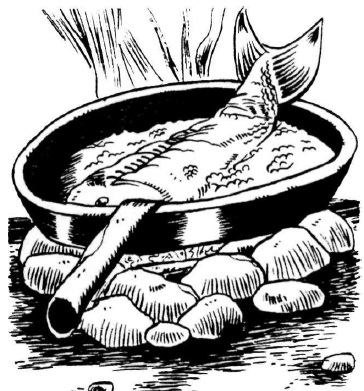
Is it just me, or does that fish have the face of Danny de Vito?
Cooking is important to Madlanders but less important to me. Basically, they have little oven-pots they heat up in the fire and then use to grill, boil, or fry food; said cooking is done in the wavobak and served communally. There really isn’t anything exciting when it comes to Madlander cooking unless you like food porn, in which case…
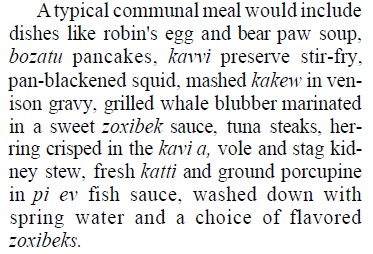
I now want to taste marinated whale blubber.
Speaking of zoxibek! It’s a wildly strong alcoholic beverage described as “thick, dark and foamy… with a throat-constricting sweetness and a sour aftertaste.” I have no idea if it’s supposed to correspond with a real drink; I dunno, tequila? Stout? Somehow I managed to go through 3 years in a fraternity without learning shit about alcohol. (In fairness, all I drank there was Jameson’s, Fireball, and shitty, shitty beer. Also, we spent more time on nerd things as we did on booze; I played my first tabletop RPG there and when I left there were 3 active campaigns and 2 homebrew systems under construction. In other words, typical frat life
 ) Both genders brew zoxibek and brewers gain great prestige; their products are usually too strong to drink without watering down and super-watered-down versions are given to kids. Though booze is beloved, being boozed up is not; drunks are shamed and censured by the community.
) Both genders brew zoxibek and brewers gain great prestige; their products are usually too strong to drink without watering down and super-watered-down versions are given to kids. Though booze is beloved, being boozed up is not; drunks are shamed and censured by the community.
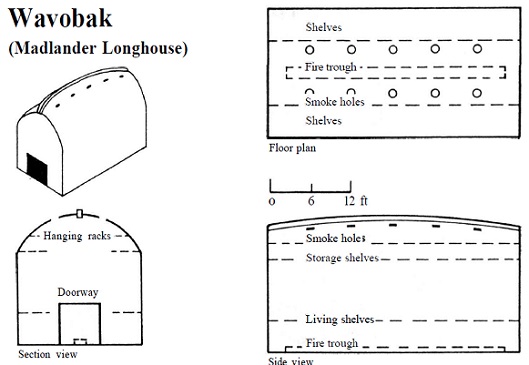
Of course Madlanders use static blueprints and build their buildings in exactly the same way!
Wavobeks are where every Madlander lives; each clan occupies one by itself. Resembling upside-down boats, these longhouses are divided up into little alcoves for each family (Madlanders like it crowed). Those wooden platforms in the diagram are used as storage in summer while people live on the rock floor; in the winter, those switch so people can stay where it’s warm. Cooking is done on wood fires in a trough down the center, while smoke holes let woodsmoke out and can be plugged to keep the heat in. Apparently, sleeping areas are covered in a periodically-changed layer of wood chips and shavings, which I believe people have to sleep in
 . I hope you like splinters!
. I hope you like splinters!
Boats are built much in the same way as wavobaks, just, y’know, flipped the other way. Speed doesn’t matter to Madlanders as much as stability and resilience, so their boats are built like floating brick shithouses and have both a sail and oar stations in case one is compromised. They also have spikes under the waterline to discourage orcas from ramming and overturning them, but there are too many ways for a particularly ornery whale to avoid them; the authors give here a proverb that is literally “build a better mousetrap”, just with anti-whale spikes. The book points out that a character could invent a new type of spike and make themselves greatly respected in the village; however, the idea isn’t alone enough to make an adventure with. Speaking of which…
Game Idea 22 : A particularly large and vicious killer whale has been hunting down the village’s boats and sinking them. Can the players come up with a way to fight back, using any means at their disposal to kill the whale?
By the way, a sidebar talks about carpenter stereotypes; Madlanders consider carpenters arrogant pricks who think they know everything and have stories to back this up. It’s a nice bit of characterization to stick in a campaign.
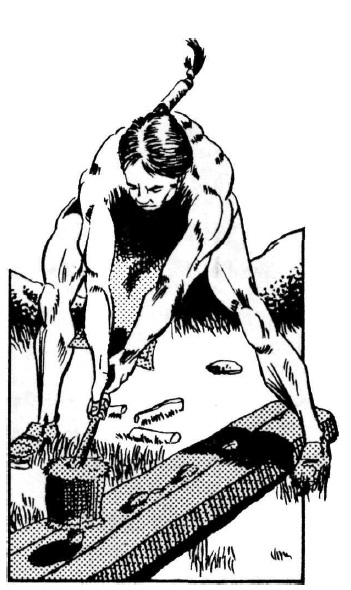
Madlanders aren’t much for technology outside of railroad construction.
Madlanders don’t really have much technological expertise. They do use iron to make weapons and a few tools, but they don’t use it in construction, crafting, or armor creation. Mostly, Madlanders build shit out of wood or bone, depending on the object, with a few objects (such as cooking pots) made out of clay. The book tells us that the reason iron tools aren’t more common and advanced is because, while women make everything else, ironworking (and boatbuilding, incidentally) are men’s work. It outright informs us that women are more creative and would totally innovate with metal if they were allowed to smith, once again reinforcing gender roles while trying to break them
 .
.
However, they do love their arts and crafts, which are mostly used for decoration. Both genders wear jewelry, men preferring necklaces and bracelets and women preferring hair ornaments and piercings; all jewelry is made with animal byproducts – or human or monster byproducts, if they’re particularly fearsome. Madlanders take trophies from monsters and intelligent beings, but they alter them before using them as decoration so they don’t cause possession. For some reason, the book gives us an entire 3-paragraph sidebar on hairstyles; men shave their heads before fishing season and sometimes wear a ponytail, women wear braids or multiple ponytails with decorative things woven in, and both genders dye their hair. Moving on.
I’d go into detail on Madlander clothing, but you’ve already seen it. There really isn’t much to talk about here, just that Madlander men also wear hats in summer (something the pictures don’t depict), most clothing is made of deerskin, and people wear heavy fur coats in winter! How interesting
 !
!
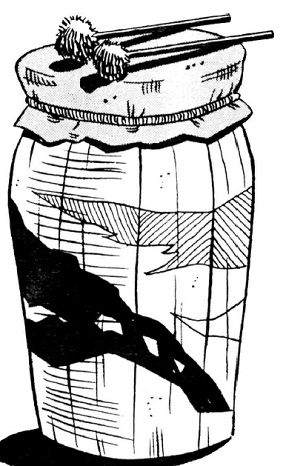
This image is too boring to give a funny caption.
Finally we get to Madlander pastimes; we’re nearly done with the chapter! The music section opens with telling us instruments are made by women and played by men, Thanks, game!
 Madlanders use wood flutes, drums, and a 3-string double bass; some songs are purely instrumental and improvisational, others include singing and follow a more set form – and this time women are included as singers! (Only men can play instruments.
Madlanders use wood flutes, drums, and a 3-string double bass; some songs are purely instrumental and improvisational, others include singing and follow a more set form – and this time women are included as singers! (Only men can play instruments.
 ) After telling us that songs tend to focus on mundane emotion instead of great events like stories and are often used to cope with death, a sidebar gives us some examples; a pair of lovers are separated when one is kidnapped by Savarginians and they die longing for each other (
) After telling us that songs tend to focus on mundane emotion instead of great events like stories and are often used to cope with death, a sidebar gives us some examples; a pair of lovers are separated when one is kidnapped by Savarginians and they die longing for each other (
 ), an outlaw is so miserable he provokes some hunters into killing him (
), an outlaw is so miserable he provokes some hunters into killing him (
 ), a tribunal is called against a couple accused of shamanism in which it’s revealed the elder that called the tribunal is guilty instead (
), a tribunal is called against a couple accused of shamanism in which it’s revealed the elder that called the tribunal is guilty instead (
 ), and, jarringly, a comic song where two guys compete over a girl’s heart and get so caught up in the contest they lose the girl to someone who’s actually accomplishing things (
), and, jarringly, a comic song where two guys compete over a girl’s heart and get so caught up in the contest they lose the girl to someone who’s actually accomplishing things (
 )
)
Game Idea 23 : The details of a villager’s songs describe another villager too closely for comfort – a sure way to invite possession. Why are they doing this? Are they a shaman? Are they just stuck in their ways? Will the target villager do anything about it?
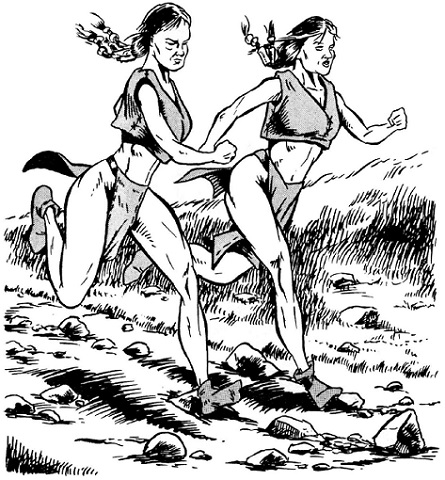
The disadvantage of loincloths.
Games!
 and just have somebody with a good memory keep tract of them all. As games serve the purpose of diffusing tension through fair competition, cheating in a game
is viewed as a possible indication of possession or shamanism which can lead to execution or exile
and just have somebody with a good memory keep tract of them all. As games serve the purpose of diffusing tension through fair competition, cheating in a game
is viewed as a possible indication of possession or shamanism which can lead to execution or exile
 .
.
Beetle fighting is popular; villagers take not-stag beetles, train them and paint them in clan colors, and have them fight until one gets flipped over. Foot races (pictured) and not-Mahjongg are also common, though not-Mahjongg mystifies me; the book tells us straight up that they use traditional patterns as the scoring method, but doesn’t repeating any pattern in anything invite possession? The book also mentions not-hackeysack in some detail, and not-chess, not-dice, vole racing, and wrestling without detail. But there is one game that outshines all the others, a game I saved for last.
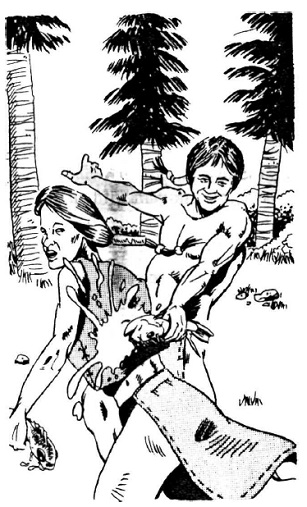
These two like getting each other sticky.
Normally, the games described in the book have their name given in Madlander, often with a translation. This game is just called Trouble Fish, with no translation given. Before the game, each villager is given a basket with three of those useless fish mentioned earlier coated in glue. The idea is to run around the village slapping each other with fish, as a slapee is visibly fished and out of the game; no physical contact is allowed between players outside of fish-slapping but otherwise anything goes. Stealth and cleverness are rewarded with victory except in two situations; the glue can be dissolved in seawater, so any wet player is automatically disqualified, while leaving village limits also disqualifies you. You’d think that means someone could cheat by dumping water on a rival, but the authors already indirectly covered that; cheating is bad and a sign of supernatural fuckery, children! Finally the book points out everyone of every age and gender plays Trouble Fish (as long as they want to). And we’re done!
THOUGHTS: A lot of this stuff is really interesting and would make a fun addition to a game, but there’s just too much material to work in to keep a game moving. Of course, you have the option to ignore some parts and just through in what you want and keep the rest separate; however, so much in this chapter is intertwined that many parts can’t function without other parts, which can’t function without other parts etc. etc. Despite this, this chapter is really valuable for fleshing out Madlander society, providing context for the players, and giving people hooks to latch onto and understand the culture they’ve been thrown into. I give it a B+.
Game Ideas: 23
Should I stop doing these? I think I've made my point.
The next chapter is about making characters, and since nobody cares about GURPS’s mechanics except for me I’ll skip it. However, I’ll use it to make characters for you all! If you have any ideas, give me an English name or indicative phrase, character concept, and level of ability (one of village hero, local leader, ordinary shmuck, or poor unfortunate soul) and I’ll whip something up for you. Then, we can get to the gods that make the Madlands so, well, mad.
Next Time: JESUS CHRIST
GODS
Original SA post GURPS FANTASY II5 – GODS
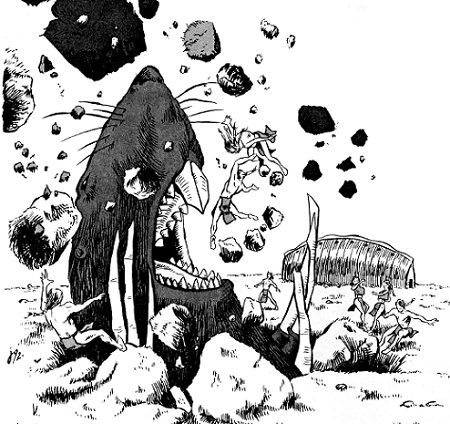
I think this means winter will last forever.
The gods of the Madlands are the ultimate source of its supernatural troubles. Though it seems weird to ask if a god can be insane, these ones certainly appear to be; nothing they do is consistent 'cept for Bett Agwo, we'll get to him) and they warp reality around them in unpredictable ways. According to the book, encounters with the gods should be exceedingly rare, usually indirect, and always significantly alter the campaign. Most Madlanders never meet a god, but those that do are invariably marked by the experience due to the gods’ malevolent supernatural power; they should be saved to shake up a campaign or as the capstone to a long sequence. Of course, the way the gods are portrayed makes them so intimidating they seem like they’d ruin a campaign just by showing up; while the book does point out they’re portrayed in such an inconsistent light so the GM can shape them to the situation. While my gut instinct is to keep them out of reach for their character-ruining potential, they do seem to have uses in-game so

Summoning a god to borrow some of their power makes one a shaman, but being a shaman is tough; you can’t often call them if you really want them to come, so you have to clear your mind Zen-style just to get them to come around. Even if you do manage to summon one, getting it to listen to you is a trial; they’re nuts, after all, and even if they decide to help you out they may just fuck up and turn you into a monster or something. The insanity of the gods extends to their behavior; the GM is encouraged to have rules the gods follow but change them up from time to time, allow them to travel through space and time, and alter their personalities to keep players guessing. The book also suggests they might be beholden to outside forces that modify their behavior, but I feel that cheapens their unpredictability so fuck that.
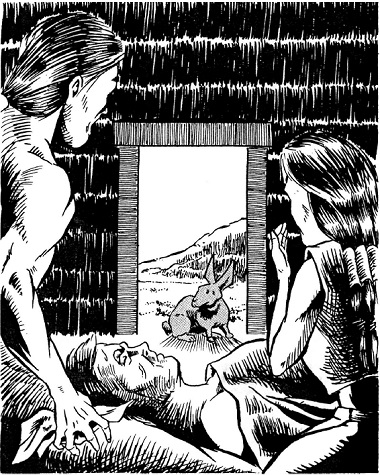
Would you like to sign a contract?
Bax Powu Kag, the moose, is not depicted above; he has no picture
 . He manifests as a weird moose-like animal with grey fur and usually no antlers and he generally avoids humans; nobody seems to know all that much about him because of that. What everyone
does
know is that he’s a happiness vampire; just entering his presence is enough to inflict depression on humans. His effect is described as stripping people of “all of their mental defenses against the harsh realities of the Madlands”, making his victims sink into self-pity or pessimism, lose hope, and develop obsessive habits and nervous tics. Some people become so desperately unhappy they attempt suicide
or just give up, stop moving and starve to death on the spot
. Though he’s not the greatest guy to be around, it is possible for shamans to borrow his aura of sadness. If spoken too, he’s just as depressed as you’d guess from his aura.
. He manifests as a weird moose-like animal with grey fur and usually no antlers and he generally avoids humans; nobody seems to know all that much about him because of that. What everyone
does
know is that he’s a happiness vampire; just entering his presence is enough to inflict depression on humans. His effect is described as stripping people of “all of their mental defenses against the harsh realities of the Madlands”, making his victims sink into self-pity or pessimism, lose hope, and develop obsessive habits and nervous tics. Some people become so desperately unhappy they attempt suicide
or just give up, stop moving and starve to death on the spot
. Though he’s not the greatest guy to be around, it is possible for shamans to borrow his aura of sadness. If spoken too, he’s just as depressed as you’d guess from his aura.
Bax Powu Kag is, I think, most useful for turning points in a character’s life. The depression and introspection he causes are catalysts for reflection and can change a character’s life. However, that pressure could very easily go wrong. I guess you could say that for the other gods, though. They all pose issues for use in a campaign, but, eh.
Pictured above is Bett Agwo, the Hare. Unlike his fellow gods, Bett Agwo is aware of his godhood, only shows up as a regular hare instead of a giant magic whatever, has a consistent personality, and actively tries to help the people he encounters. He still can’t avoid the supernatural fuckery of the Madlands. Bett Agwo is a twisted wish genie; he’ll listen to any request given by a mortal, grant it, and make them wish they’d never asked. If you want to recover from sickness, you’ll get better before catching something worse; if you want to be invulnerable, he’ll cover you in scales that forever mark you as a monsters. If you ask to never see him again, he’ll take away your eyesight – and that still won’t prevent him coming back since he often shows up in dreams and hallucinations, and since summoning Bett Agwo is as easy as focusing on his name or having unfulfilled needs (excess emotion fucking you over is a serious theme in Fantasy II, just you wait and see). The wishes he grants aren’t intentionally harmful, but they’re always negative, so don’t try to find him again and get him to reverse it. If spoken to, Bett Agwo is distracted, wordy, and forgetful, with a low quavery voice.
Bett Agwo embodies the Madlander conception that good intentions don’t compensate for bad outcomes, and he’s there to teach that to players. I’m not a huge fan of him since he’s so one-note – he shows up, fucks you up, then gets up and goes, every time – and he’s a bit too much of a gotcha to use on players unless you’re a dickhole. However, he makes a great backstory character and a solid randomizer if applied to NPCs.
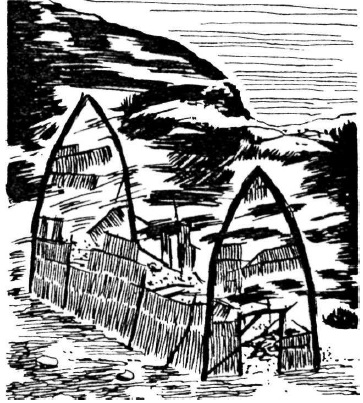
I have no idea what’s going on in the background here. Is it the gods?
Though Bett Agwo almost always shows up as a regular-looking rabbit, other gods aren’t consistent in appearance. The way they manifest varies wildly; they might be encountered as transparent versions, disembodied body parts, completely disembodied voices in the woods, normal except for see-through skin showing internal organs, fading in and out, black-and white, shapes with fewer or more dimensions than are strictly necessary, hallucinations or visions, constructed from nearby materials like pine needles or boulders (they sometimes leave these temporary bodies behind as stat), transforming into something else or all of the above. If they show up as something visibly impossible, they inflict insanity Call of Cthulhu-style.
Since just being around the gods can bring on the crazy, the book advises you (as I mentioned earlier) to be indirect and have them encounter divine detritus. Some areas look normal, only to turn out to be cursed and slap your characters with disadvantages (please don’t do this to your players). Others are the opposite; though nothing’s actually going on, it might look like some supernatural shit is up and inflict the appropriate traumas. Some places inflict emotions on characters relevant to a particular god, while others are occupied by monsters or mutants (there are mutants in this game, I’ll get to them probably next chapter). In the Madlands, even the aftermath of godly presence isn’t permanent; any and all supernatural effects fade with time, but it’s impossible to be certain when, quote, “the spoor of a god” fully wears off.
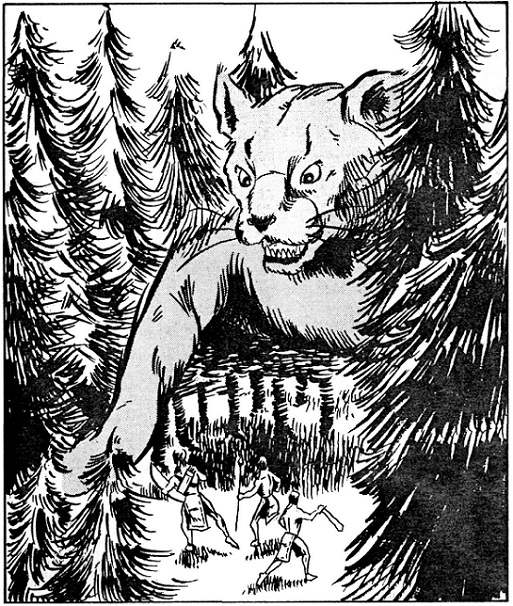
Holding your sword like that just makes you look like a tool, guy.
Gakox Pezep, the Cougar, is described as the most dangerous god of all – even though they said the same of Bett Agwo three pages back
 . His most notable trait is his split personality; sometimes he’s a polite, gregarious fellow with a raucous sense of humor, other times he’s a wild man-eating animal that destroys everything he comes across – he even destroys things as he travels, taking great leaps that leave craters behind. Which of the two you’re going to get is unpredictable and they can switch at a moment’s notice. The book mentions him razing a village, popping into friendly-form, and asking what all the fuss is about.
. His most notable trait is his split personality; sometimes he’s a polite, gregarious fellow with a raucous sense of humor, other times he’s a wild man-eating animal that destroys everything he comes across – he even destroys things as he travels, taking great leaps that leave craters behind. Which of the two you’re going to get is unpredictable and they can switch at a moment’s notice. The book mentions him razing a village, popping into friendly-form, and asking what all the fuss is about.
If your characters run into Gakox Pezep, they ought to be real careful; anything from smelling blood to discourtesy can flip him from oh-hey to oh-fuck, and he’s an unstoppable bouncing force of destruction in the latter. He can be helpful to his shamans and lucky encounterees, but usually he just eats them. Or invites them to a tea party. Either-or. In game, Gakox Pezep mostly useful as a threat of some kind, either menacing the village or stomping something into oblivion and changing the game.
Bubzavav is a giant, sentient bear. He’s generally portrayed in Madlander stories as single-minded, eternally hungry, and kinda stupid; he’ll eat grass, mushrooms, deer, honey oh my christ I give up he’s Winnie the Fucking Pooh . I was going to be so clever and reveal the gods are Winnie the Pooh characters at the end of the chapter but it’s staring me in the fucking face . Bubzavav is cheerful and polite (when he’s not cheerfully eating people). Bubzavav is eternally hungry. Bubzavav has “light brown, almost yellow” fur. Bubzavav is described as “roly-poly”. Bubzavav’s stomach and the word “rumble” are mentioned together three times. BUBZAVAV ONCE GOT STUCK IN A HOLE CHASING BEES FOR THEIR HUNNY AND PIGLET FAILED TO HELP BY PUSHING HIM FURTHER IN. Fuck this GURPS Fantasy II, if you can’t be bothered to take your setting seriously I’m out.
I hurt my eyes recently and I can barely stand to look at the screen, I’ll finish this chapter when reading things doesn’t make me want to gouge my face out.
MORE GODS
Original SA post GURPS FANTASY II5.5 – MORE GODS
It’s been a goddamn long time since I made the last post and Madlands is complicated and involved; you may want to check the archives and skim the rest of the review before reading. Or don’t. Or ignore the post

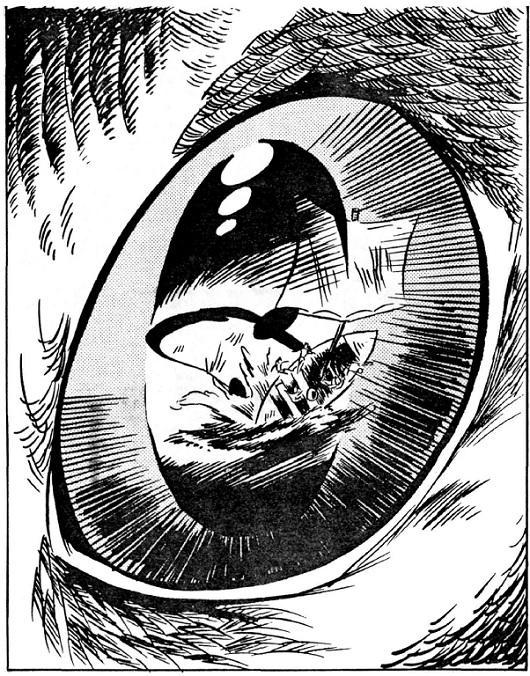
Madlander TV is pretty wild.
Vuvuti, like many mythical owls, represents knowledge and wisdom. Vuvuti, like all Madlander deities, represents shit you want to stay away from. He tends to manifest as a big honking horned owl, usually human-sized, with massive dishpan eyes. If you come too close to him, your gaze will slowly drift towards those eyes – and in them, you’ll see something that fucks you up. Sometimes, you see an image of your doom; sometimes, what you see causes a realization so horrible you go crazy; sometimes, you learn a secret that’s dangerous to act on – how to become a shaman dedicated to him, for example. As far as Madlander gods go, though, his particular brand of shamanism is light; in exchange for the ability to see the future, find hidden objects, and learn secrets, he just wants to peck out your eye. Every power he grants you comes at the cost of a body part, but that’s all Vuvuti wants from his shamans; you don’t get the tasks and personality bleed you might from other gods after signing up. In Madlander stories his personality is unclear (he never talks), but he’s said to have “a jeering contempt” for humans; he’s also, you know, an owl, and he hunts like an owl does, including hunting human children (not like an owl does).
As far as Madlander gods go, Vuvuti is pretty good for games; his visions are great for sparking quests to save doomed villages or go adventuring deep into the Madlands, while his shamans make great villains. Since they only have to give up body parts with no further strings attached, Vuvuti shamans have freedom of movement and incredible intrigue potential; the only way to identify one (aside from catching one casting a spell) is to look for lost body parts, which are pretty common in a place as dangerous as the Madlands. Until then, the shaman has spells that can tell them who’s after them, what they know, and how to fuck them up, but typical Madlands magical corruption gives them reason to slip up enough that the PCs can outsmart them. A-, would use.
Madlands gods, for all their inherent violence and insanity, seem to actually get along pretty well. According to the storytellers, when they show up together the gods usually act in some kind of parody of Madlander behavior; they’ll race beetles, play that sticky-fish game from earlier (and occasionally temporarily kill each other with sticky killer whales), go on picnics, or just have conversations. Sometimes they’ll play pranks on each other or use their powers on eachother, always to disastrous results. You’re still as fucked as usual if you run into them when they're hanging out.
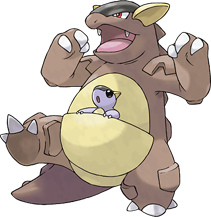
The book doesn’t include pictures of them, so here’s a highly accurate depiction of Kikavo Vo and Kikavo Dat from the internet.
The Kikavos are unique among gods; they don’t resemble any known animals, they have an obvious familial relationship, and Kikavo Vo is the only female goddess. In the stories, their appearance is consistent:
”GURPS FANTASY II: Adventures in the Madlands” posted:
[T]hey have the heads of deer (without antlers) mounted on long thick necks. Their chests and torsos are like those of big potbellied grizzly bears. Their postures are upright, like a man's. Mounted on their shoulders are tiny arms like those of a small child. On the end of each arm are the sharp claws of a wolverine. Their powerful legs are designed like a toad's, but their huge feet resemble those of no known beast, long and flat like planks from a ship deck. With these fearsome appendages they bound across the landscape, leaping miles at a time, smashing anything they touch down on. They anchor these leaps with a thick tail, resembling a shortened squid's tentacle, protruding from their hindquarters. Their freakish bodies are covered from head to toe in thick brown fur like a moose's.

Kikavo Vo, the mom, usually tries to be nice; of course, being a Madlands god, she’ll "help out" by dissolving your broken bones or smashing your burning house flat. The only time she gets angry (as opposed to her normal malignant benevolence) is when Kikavo Dat, her
Kikavo Dat is specifically described as a sadistic seven-year-old with phenomenal cosmic power. He’s hyperactive as hell and spends most of his time running around and fucking with things, often catching people and taking away parts of their essential natures just to see what happens. You can reason with him to get him to stop, sort of, and you can sometimes keep him happy until he gets bored and hops away (or he’ll turn your balls to butterflies); either way, you might catch his ADHD like the flu, get akathisia, or even regress to childhood. Some stories have his shamans turned into kids or just be children straight-up.
I’m not a huge fan of the Kikavos. They just don’t do jack as far as stories are concerned; everything Vo does is covered by another god, while Dat’s association with children is just uncomfortable. I’d avoid them if you want to put a Madlands campaign together, but, well, whatever.
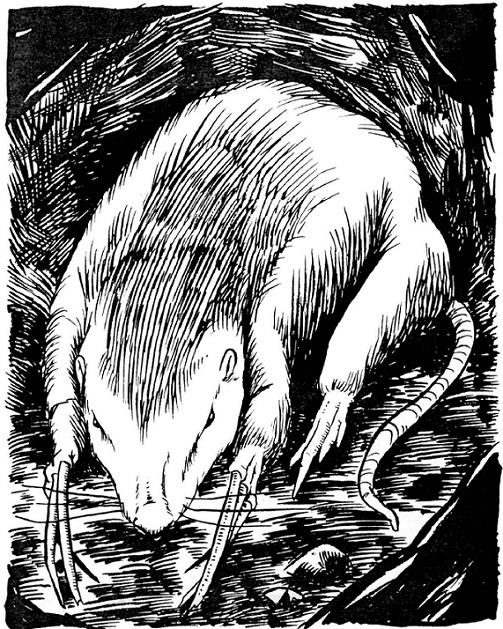
Aww, lookit dose widdle claws

Madlanders don’t see Zewa Zab much compared to other gods (not like the gods are common), but they do stumble across his tunnels constantly. He’s described as a gopher, which in this universe means he spends all of his time digging tunnels through the landscape; he doesn’t seem to give a shit about anything else, to the point where stories involving him have him talk about only tunnels at lightning speed. His tunnels might follow a pattern, or they might be random, or some mixture of the two (nothing is mutually exclusive for Madlands gods), but nobody knows because nobody risks haunted tunnels or godly attention to enter an unexplored tunnel network. As far as gods go, he’s pretty harmless; sometimes he’ll eat people in his way or nab a tuber harvest on his way to wherever he goes, but he usually ignores you otherwise. Hooray for lesser evils! Not for his shamans, though. They use tons of earth magic and hide out in his tunnels when not doing whatever it is shamans do in their free time.
Zewa Zab, game-wise, is mostly useful as a background character. His tunnels make reasonably good hiding spots for various monsters and his shamans make for solid opponents with ready-made hidey-holes. What else can he contribute to a campaign? Nothing! Least as far as I can tell.
So, gods are pretty rare as far as encounters with Madlanders go (most Madlanders never meet a god); also, if they stuck around all the time they’d have driven everything extinct a long time ago. So where do they go? Nobody knows, of course! Storytellers can’t agree on this, which is probably a good thing, since someone who knows where the gods live is probably a shaman. The book forwards theories about them living above the clouds in some kind of heaven/hell, distant realm beyond even the Whiteness, a pebble in the Madlands interior, or some cold, dark place where dimensions shift constantly (the book connects this to the Soulless, one of the weirdest parts of GURPS Fantasy II). One story has a shaman philosophizing that the gods are quantum particles and only exist when folks want them to deep down, but his speech is cut off mid-sentence by Zo Do Wabda, natch. GM’s can choose one or more truths; as I said earlier, nothing is mutually exclusive for Madlands gods.
The last god in the Madlands is Zuutak, the only name (or word) in the entire Madlander language to use a double vowel. Why?

That’s why. Zuutak is a giant pig that loves crops. Which is great, because he’s the most likely god to show up in a village. The double vowel in his name is the speaker shouting a warning to everyone within earshot. While tubers aren’t necessarily the most valuable food source in Madlander society, they’re a key source of flavoring, alcohol, and most importantly, nutrients. If Zuutak swings by, your entire tuber crop, months of hard work for your alcomahols, is fucked (also possibly your tuber storage and wavobeks if he feels like it). But that’s not the worst part. Like any god, places Zuutak visit tend towards plagues of monsters and hauntings. Unlike any other god, Zuutak mostly shows up in villages (though he occasionally wrecks stretches of landscape hunters stumble upon). The book doesn’t touch on this, but if those parts of the wilderness Zuutak fucks up develop paranormal bullshit, the same probably goes for villages! A Madlander village sits on a razor’s edge in the best of times; the destruction Zuutak leaves in his wake, even if he just eats some crops and disappears, might just be enough to scatter the village entirely.
According to the book, a village has 11-13 clans, each with 50-75 members in its extended family. This means the minimum population of a village is around 550. The total Madlander population, also according to the book, is around 25,000; therefore, there are, at maximum, roundabout 45 and a half villages in the Madlands. And, once again according to the book, Zuutak attacks “only one or two villages a year”. Granted, this is math applied to population figures in a game world, so its naturally fucked and probably inapplicable. But if it is, that means most Madlanders see Zuutak at least once in their lifetime! And some encounter other gods too! And the book says most Madlanders never see the gods once in their lives! If I had to guess, it’s just a minor math error a GM could handwave away or straight-up miss while reading this section through. There’s little else to say about him; he doesn’t show up much in Madlander stories, and his shamans mostly spend their time stealing food from villages like a grimdark cartoon robber.
Zuutak is, I suppose, mostly useful as a threat or source of anxiety for campaigns; did the next village over get hit by Zuutak? Did a friend of yours run into him disguised as a normal boar in the woods (according to the book, no matter what size Zuutak is “all of his destructive power remains intact”; imagine running into a boar that can gore a person with enough strength to crush large buildings
 ). I can’t imagine using him as much more than that, you don’t want to kill your characters
too fast.
). I can’t imagine using him as much more than that, you don’t want to kill your characters
too fast.
Incidentally, this creature associated with anxiety will sometimes show up as tiny and bright pink. I can’t imagine why

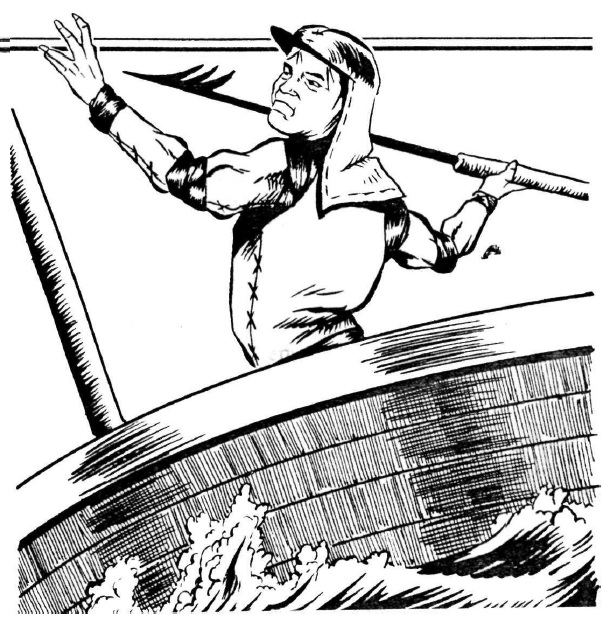
This chapter has run out of pictures, so have Popeye’s angry cousin next to rules for training beetles. A dirt-average character needs to spend 8 out of 100 starting points to successfully train a beetle more than 2/3 of the time! :gurps:
Before we leave the gods behind, it’s worth quickly noting that their domain is limited to the Madlands; foreigners unfamiliar with the Madlands tell the locals they’ve never heard of the gods (the book doesn’t note whether the xenophobic and suspicious Madlanders would believe them). No god can travel beyond the coastline under any circumstances, but the book doesn’t say what happens if a god approaches the coast chasing someone which I imagine would be important if it happened in game but
 . Nothing, at all, supernatural crosses the shoreline; gods don’t, monsters don’t, shamans can but their powers don’t work. What happens if you bind up a monster and load it onto a fishing boat? Good question! That’s probably a terrible idea, though, so that’s unlikely to come up in game. As it so happens, this border stretches around the Madlands across land borders with other cultures as well; the mountain range that divides the Madlands and Togeth and an indistinct line somewhere up in the Whiteness also seal out the supernatural, sort of, though those seals aren’t as impermeable as the sea. Some gods and monsters can cross them sometimes, but they avoid doing so if they can for whatever reason.
. Nothing, at all, supernatural crosses the shoreline; gods don’t, monsters don’t, shamans can but their powers don’t work. What happens if you bind up a monster and load it onto a fishing boat? Good question! That’s probably a terrible idea, though, so that’s unlikely to come up in game. As it so happens, this border stretches around the Madlands across land borders with other cultures as well; the mountain range that divides the Madlands and Togeth and an indistinct line somewhere up in the Whiteness also seal out the supernatural, sort of, though those seals aren’t as impermeable as the sea. Some gods and monsters can cross them sometimes, but they avoid doing so if they can for whatever reason.
Alright, Chapter 5 is over. The whole section’s utility in gameplay is questionable; the gods are good for setting background and some story seeds, but every single one of them is powerful enough to wreck campaigns if your GM is sadistic enough to set up a godly encounter - and, of course, the forethought that characterizes a lot of this book wore out near the end because even the authors started to figure out this part wasn’t worth the effort. Meh, I guess. I’d complain about wasted page space, but my copy is a 31-meg pdf so who cares.
It occurs to me that, since GURPS is (obviously) the complete wrong system for Madlands, PbtA would handle it a hell of a lot better. Or maybe some kind of King of Dragon Pass mod. That’d be neat!
Next time:
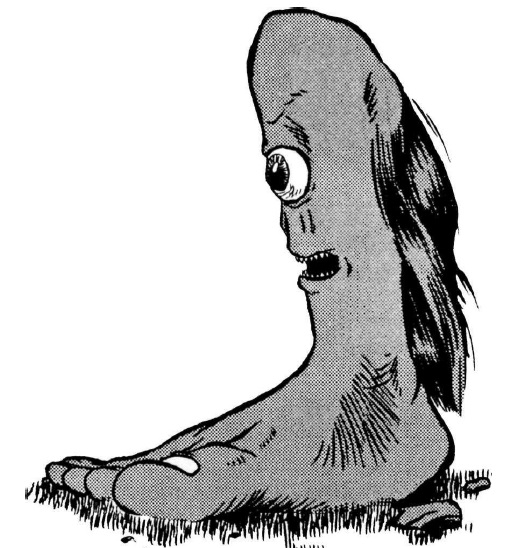
MONSTERS
Original SA post GURPS: MADLANDS6 – MONSTERS
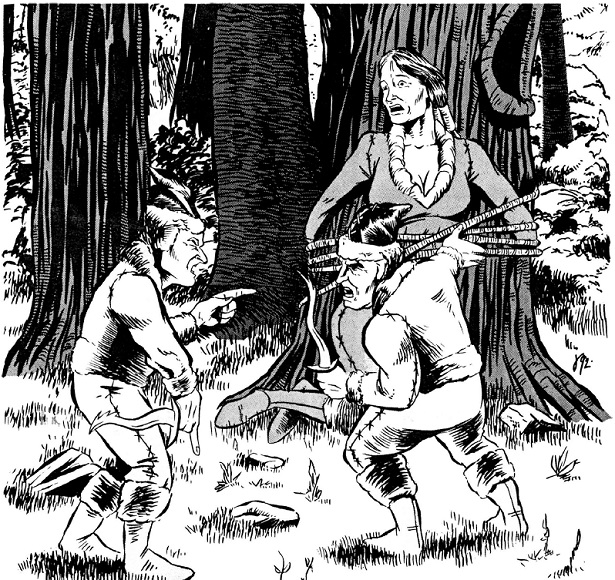
Santa’s elves finally stage their rebellion.
The gods of the Madlands are distant, alien, and rarely encountered. The monsters of the Madlands are none of those things. In general, hunters will encounter one of these things at least once a year, possibly more, which is bad because their stats are fucking bonkers to a man. Monster. Monster-man. While the gods symbolize Madlander failings in a more abstract, generalized way, monsters hit much closer. I could go through the gods without delving into what they mean in Madlands culture. I can’t describe any monster with describing what happened to him or her first. Yes, “him or her”. Every Madlands monster used to be a human being.
Madlanders view monsters in terms of what they’re missing; while each creature lacks some part of a normal human’s body, they also lack a part of their basic humanity, something that holds their minds and morality together. This, by the way, is part of why few Madlanders fear a violent death: it’s one thing to pass out of the world in violence; it’s another to be bound in your body afterwards, insane and animalistic until something takes you out of the world by force. To Madlanders, society is literally built into human blood, and becoming a monster corrupts your blood and makes you incapable of social function. The book goes out of its way to say this theory is a best flawed, though, so
 . Still, all monsters are anti-social in the “actively destructive to others” way.
. Still, all monsters are anti-social in the “actively destructive to others” way.
”GURPS Fantasy II: Adventures in the Madlands” posted:
Monsters are no more capable of self-sacrifice or compassion than a chipmunk is of flying.
”GURPS Fantasy II: Adventures in the Madlands” posted:
Since anyone who dies without being given a proper funeral becomes some sort of undead menace…
Anyway, any victim of a god attack will turn into a monster depending on what body parts they lost; there isn’t a huge stable of them to pick from, but it’s enough to cover most possible bizarre deaths. The transformations aren’t consistent between death, naturally, so people killed one way might turn out differently. That way you can’t be prepared! The gods seem generally friendly to monsters and won’t seek them out for violence, but if they do get attacked, they’ll turn into different monsters. That way they can’t escape!
You’re advised to treat monsters less like DnD and more like horror movies. Even the shittiest monster can go toe to toe with experience warriors and their appearances are disturbing enough to force a SAN check. Build up slowly, drop hints, describe a trail of destruction, show victims; make a monster as intimidating as possible before the party encounters it. The book tells you not to pull any punches if your players charge organ-skeletons willy-nilly and to “show no mercy” (and this for characters that can die if a thrown rock happens to crit). That’s kinda bad! The book then tells you always leave a way for players to escape! That’s better! The book also tells you to make your players pay close attention to their surroundings and situation (/read your mind if your bad at describing them) in order to escape. That’s kind of neutral I guess!
Disclaimer: This review was prepared by Falconier111 in his personal capacity. The opinions of monster meanings expressed in this article are the author’s own and do not reflect the views of Robin D. Laws, Steve Jackson, or Steve Jackson Games Incorporated.
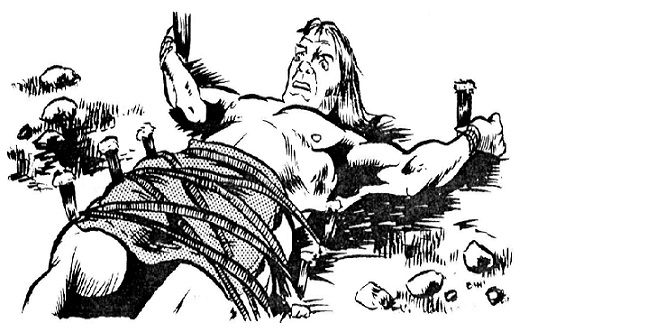
I have the weirdest stake right now.
Bloodless are vampires in constant pain that can only be solved by human blood (not animal blood, this was before Twilight). If they spend too long without said blood they turn all gross and ghoulish and their skin dries out to the point that sometimes their noses decay and fall off (they have to bandage their face or all the blood they drink will spray out their nosehole
 ); additionally, their intelligence will start to permanently decline until they become pseudo-zombies. To wit;
); additionally, their intelligence will start to permanently decline until they become pseudo-zombies. To wit;
”GURPS Fantasy II: Adventures in the Madlands” posted:
The more brain-dead ones may have little to say beyond "Blood! Blood! Blood!"
 . As focused on blood as they are, some are smart enough to learn shamanism (yay!) and practice population control to keep blood consumption in check, hunting down and killing excess bloodless and delivering their victims to their communities so they get properly buried instead of turning into competition. Speaking of which!
. As focused on blood as they are, some are smart enough to learn shamanism (yay!) and practice population control to keep blood consumption in check, hunting down and killing excess bloodless and delivering their victims to their communities so they get properly buried instead of turning into competition. Speaking of which!
Three ways to become bloodless; gods, contagion, and misbehavior. As mentioned earlier, any encounter with a god that removes one’s blood (Dopod Abwep boils it away, Gakox Pezep drinks it, Bett Agwo turns it into butterflies, etc.) turns one into said monster; bloodlessness also spreads to dead victims, which is why smart bloodless return their victims to their communities. Greedy and cowardly Madlanders can also become bloodless eventually. At first they’ll get good and gluttonous, then they’ll need to eat enormous amounts just to stave off hunger. Finally, they’ll see someone shed blood, go crazy from thirst, and kill the person before fleeing into the wilderness. But, before that point, community interventions and behavior change can fully reverse the process, a theme that’ll keep coming up.
Bloodless are parasites and represent parasitic people; it’s why they evolve from the greedy instead of the outright predatory. Bloodless consume their victims like gluttons and cowards consume the village’s resources without giving back.
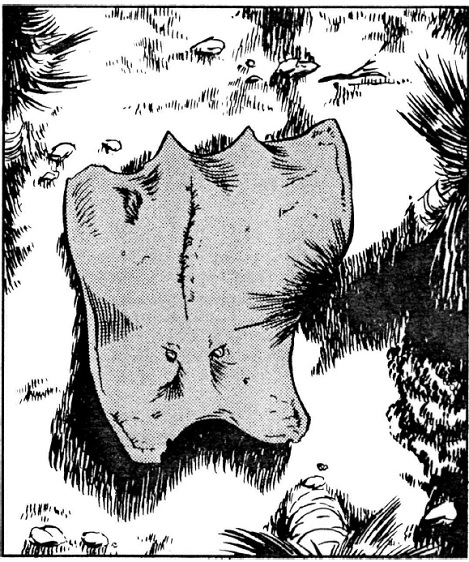
Let’s name the monsters, the monsters, the monsters; let’s name the monsters of the Madland sea!
Boneless are… well… they aren’t
”GURPS Fantasy II: Adventures in the Madlands” posted:
The boneless are great flopping sheets of skin that fly the Mad Lands' interior in search of prey. They move through the air as a manta ray swims through the ocean. Their hides match the complexion of Madlander skin. A pair of human-looking eyes is mounted front and center on its top surface. Anyone foolish enough to closely examine a boneless will discover vestigial remnants of its original human form scattered randomly about its hide - an ear, a few teeth, some hair, a nipple. Along its underside they'll find hundreds of enlarged pores about a fifth of an inch in diameter. In living specimens each pore will be sealed with a layer of yellow mucus.
 but meaningless illusions! Naturally, victims might get phobias or nightmares related to blankets, being smothered, or acid.
but meaningless illusions! Naturally, victims might get phobias or nightmares related to blankets, being smothered, or acid.
Boneless are also excessive consumption, but turned outward instead of inward. A hunter kills more than he can carry, a fisher throws harpoons fish and throws them back to pass the time, a boneless that mindlessly consumes people; these are similar to a Madlander’s mind. Taking from the environment for no purpose will weaken it and, eventually, you.
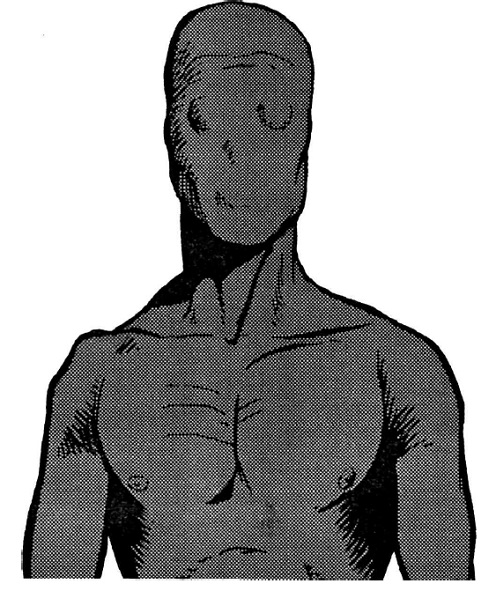
Even in death I'm still ripped.
Faceless exactly resemble ordinary humans except for their face; it’s not that they lack ordinary facial features, but they have a layer of flesh completely concealing them. Unlike the last two monsters, they don’t want to harm humans; they’re lonely and they just want to be your friend
 . Unfortunately, they are also bad friends. If you come within roughly arrowshot distance a faceless will try to grab onto you while mewling pitifully, which would be creepy enough if it didn’t bring a cloud of bad luck with it. Terrible events follow faceless as eagerly as faceless follow humans, often extreme things like lightning strikes, monster attacks, and earthquakes; they even have personal effects like worsening trauma from previous monsters, causing illnesses to recur, and opening up old wounds! This extends to efforts to harm them (the book tells the GM to apply a blanket penalty to die rolls based on the faceless’s proximity, at their discretion) and I guess to efforts to escape them too because, well…
. Unfortunately, they are also bad friends. If you come within roughly arrowshot distance a faceless will try to grab onto you while mewling pitifully, which would be creepy enough if it didn’t bring a cloud of bad luck with it. Terrible events follow faceless as eagerly as faceless follow humans, often extreme things like lightning strikes, monster attacks, and earthquakes; they even have personal effects like worsening trauma from previous monsters, causing illnesses to recur, and opening up old wounds! This extends to efforts to harm them (the book tells the GM to apply a blanket penalty to die rolls based on the faceless’s proximity, at their discretion) and I guess to efforts to escape them too because, well…
”GURPS Fantasy II: Adventures in the Madlands” posted:
Secondly, faceless are relentless once they decide to follow someone. Even hacking them apart doesn't stop them. If a faceless' legs are chopped off, it'll pull itself forward with its arms. If its arms are removed, it'll edge along on its stomach muscles like a caterpillar. If decapitated, its head will roll towards the one it seeks. If the skull is cracked open, the exposed brain will crawl out and creep on ahead. Other severed parts may also continue the pursuit: one victim may be pursued simultaneously by a faceless' head, both arms, torso, legs and ambulatory entrails. Each part carries the same degree of bad fortune as the whole.
Faceless are solely god-generated – Dopod Abwep will burn your face off while giving you a hug , Bax Powu Kag can sad your face off apparently, Gakox Pezep, Bubzavav, and Zewa Zab might bite your head off because that counts as not having a face. Psychological damage after a faceless encounter could include paranoia based around being followed, phobias of losing facial features, or hallucinations of others’ faces melting away (possibly followed by violence towards them).
Faceless are those who rely too much on their neighbors. While bloodless-analogues intentionally exploit the efforts of others, faceless-analogues don’t want to be a bother. However, they’re so emotionally reliant on others they lack the confidence to contribute anything to the village. Whatever faceless-analogues do contribute, their efforts lack dedication and focus as they seek approval from others over actual skill.
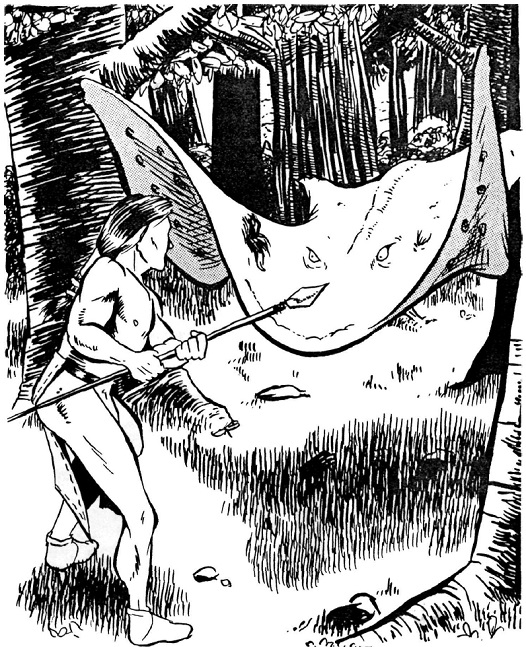
I couldn’t find a fleshless picture so have another boneless i guess.
It’s kind of a shame fleshless don’t have a picture as they’re one of the weirdest monsters in the book. Just like their name implies, they lack skin and muscle, but everything else is still there; their eyes, internal organs, tongues (yeah, I know the tongue’s a muscle, that’s what the book says), and even nerves dangle loosely from their skeletons. Their psyches are split by two equally powerful urges; they emotionally want to be human, and they instinctively want to destroy every human they meet. If they encounter a human in the forest, the fleshless will try to convince the human they’re human while the human tries to convince this human they know they’re human until the (real) human either gets away or lets lit slip that the fleshless is actually an organ skeleton and gets ripped apart. Fleshless don’t even want to hurt other humans; but if they get pissed off enough, fleshless will berserk and kill people (though most fleshless are made by god-fuckery, fleshless can spread fleshlessness by mutilating their victims – itself a rare occurrence as, again, fleshless don’t actually want to hurt people).
To hold on to their humanity, fleshless cling to what used to define them with such intensity they become caricatures of their former selves, which doesn’t endear them to anyone; despite this, fleshless often form their own communities and try their best to live ordinary lives. Fleshless will build “wavobeks” (lean-tos), form clans, get married, play games, tell stories, and even compete to adopt any fleshless kids who stumble along (a few will actually kidnap human children and rip them apart so they turn into new fleshkids
 ). They can’t, though. Fleshless perceive other fleshless as human enough to want to kill them and their social structures rip themselves apart in a storm of violence in a year or less. While the book definitely doesn’t state this, I’d say that the fleshless urge to kill grows stronger with their relationships; even as they form genuine connections with others, their homicidal urges increase and wear on their minds, straining the relationship until it dissolves into violence. Fleshless will never emotionally connect with anyone until the end of their bodies or the end of time
). They can’t, though. Fleshless perceive other fleshless as human enough to want to kill them and their social structures rip themselves apart in a storm of violence in a year or less. While the book definitely doesn’t state this, I’d say that the fleshless urge to kill grows stronger with their relationships; even as they form genuine connections with others, their homicidal urges increase and wear on their minds, straining the relationship until it dissolves into violence. Fleshless will never emotionally connect with anyone until the end of their bodies or the end of time
 .
.
Fleshless are fucking hard to kill; the only way to hurt them is to smash their bones, an epic task since they have several times as many hitpoints as ordinary humans. Survivors might begin to doubt that they’re actually people, or think others are impostors in human skins (the Capgras Delusion, which hits a little close to home as my grandmother is going through it), or rapidly gain or lose weight (I don’t get this one).
Fleshless are those who seek to prove themselves at the expense of the community – Madlanders aren’t friendly towards those with the anti-magic barbarian equivalent of Impostor Syndrome. If a person feels they don’t belong and try to compensate by being too helpful, they do the opposite of contributing and end up hurting the village.
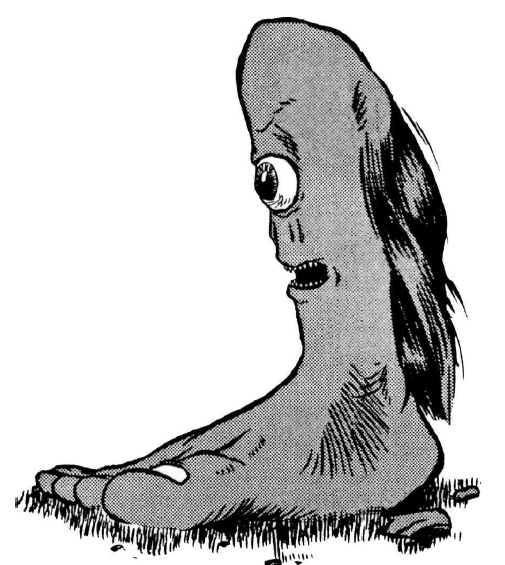
Dude, the feminist-government-Jews obviously used Obama’s fake birth certificate to put chemtrails in our GMOs. Just check out my blog for proof!
Fleshless qualify as one of the Madlands’ weirdest monsters, but that title probably goes to the Footless. Why are giant feet called footless? Madlander humor! Footless are an impressive eight feet tall and three feet long, and though they have an eye, mouth, and nostrils, they have no internal organs. They smell like feet if you get up close, of course. Footless are thought to be intelligent but universally insane; they behave unpredictably around humans and don’t do much when left alone. If you get close, you’ll hear them talking to themselves about random things – except everything they say is correct in some fashion, whether they’re talking about foreign culture, the gods, or even the listeners own thoughts. According to legend if you listen to them one single piece of important knowledge will be buried in their monologue, but good luck finding it!
Footless are only created by gods; Kikavo Dat likes to shape his victims into footless, though other gods might make them by eating off someone’s legs. Victims of footless find they’ll attack with a (shitty) bite or a (way more powerful) goomba stomp, or get slapped in the face by sorcery. Sorcery in the Madlands, by the way, is weird and associated with the Soulless, another monster type that gets a whole chapter dedicated to it. Look forward to insane immortals! Survivors might think they’ve been cursed with shamanic powers (footless don’t get shamanic powers), become obsessed with whatever they heard a footless babble, or smell only the pungent odor of giant magical feet for the rest of their lives
 .
.
Footless are those who become obsessed with learning. Madlander culture regards innovation with distrust as it might attract attention from the divine; innovators and inventors not only flaunt this taboo, but waste valuable resources in experiments and even establish accidental rituals that justify the taboo by bringing supernatural forces around for a look-see. Non-traditional knowledge is inherently dangerous in the Madlands, and pseudo-footless embody it.
Next time: headless ogres!
MORE MONSTERS
Original SA post GURPS FANTASY II6-2 – MORE MONSTERS
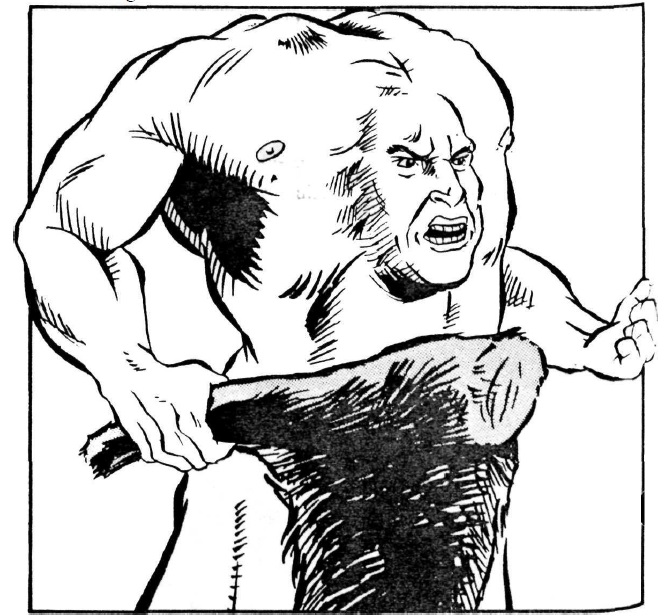
These new steroids are amazing but man, do they ever have side effects.
Headless look kind of like normal humans except for, well, having no heads and faces in the middle of their chests. Unlike normal humans, headless aren’t intelligent in any meaningful way. The only way they deal with the outside world is through violence against anything moving; animals, monsters, swaying, waterfalls, the gods. They don’t think about it, or anything else; they just use any weapons they had in life – or pick up boulders or trees – and use them to beat the shit out of things. Though headless can’t communicate in any way, they do gather in small groups and like to go a-rampaging, often targeting and destroying villages.
Headless are created when gods smash someone’s head through their body; the Kikavos and Gakox Pezep are prone to this. If they do have shamanic powers, they can’t use them and can’t even let off random sparks like boneless. Survivors of headless encounters might begin to fear crowds, develop delusions that their chest is growing a face, or begin emphasizing their individuality to irritating extents.
Headless represent mindless violence. A headless-equivalent approaches all problems with aggression and force, only for it to backfire when an attack goes wrong. Those who resemble headless in mind leave a trail of destruction in their village like headless in body.
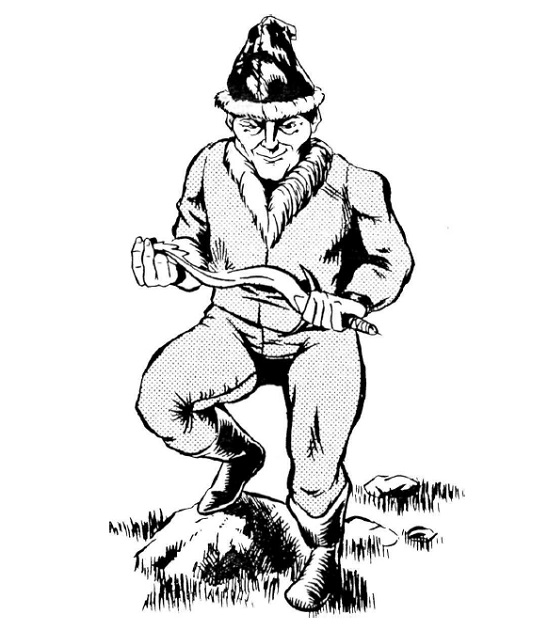
The second-worst elves in the book.
Ever heard of a redcap? No? Then how about a serial killer? Heightless are both. A few come from people smashed flat by gods. Unlike most monsters, however, most heightless originate as Madlanders. Occasionally, a Madlander will get away with murder. Such people, when they realize no retribution is coming, and even if the original murder was an act of passion, start to feel the impulse to kill again, and usually eventually succumb. As they transform into a proper serial killer, they begin to consider themselves geniuses and physically shrink (usually to something between 3 to 1 feet in height); eventually, they’ll have to flee the village before their neighbors realize exactly what they’ve become.
Heightless don’t kill humans for any emotional reasons (though murder does help them survive). They consider it an art form, choosing victims based on some twisted pattern and torturing them in some deeply fucked-up pattern before they finally expire. Heightless are solitary creatures, though if they do run into other heightless they’ll usually companionably share stories of serial killing before heading on their way; their most common “social interactions” are with people who won’t be capable of them for very long. In fact, these “social interactions” are vital for heightless – as long as they kill at least two humans a year, heightless can only die in one way. Sometimes this way is a standard way of ending a life, but other times it’s something just plain weird; the book gives beetles crossing their left boot or getting hit in the face by a robin’s egg as examples. Otherwise, damage won’t affect a heightless in any way, shape, or form. The standard way of getting rid of heightless otherwise is to wrap it in a net and through it somewhere it can’t escape long enough for it to expire in human style because a lack of murder took away its immortality. For reasons unspecified by the book, all heightless wear felt caps they dip in the blood of their victims (redcaps lol). Also unspecified is what they do if they encounter other monsters, which would be nice to know.
Psychological damage from a heightless usually hits a whole community, as heightless themselves aren’t particularly scary-looking but they tend to target multiple people. They’ll grow scared and angry, often forming witchhunts against innocents. Those who somehow survive a heightless attack will likely suffer PTSD. Most don’t; heightless are scary. Becoming a heightless significantly boosts a character’s physical skills and wildly boost their mental skills; though I won’t get into how and why this works here because fuck GURPS’s mechanics, but trust me, this makes them plenty dangerous in encounters when added to their, you know, invincibility.
In the villages of the Madlands, no person is truly irreplaceable. The heightless back up this notion by attempting to refute it. From a heightless’s point of view, they are geniuses and ordinary people like ants; to ordinary Madlanders, heightless are insane sadists. Elevating yourself above others through skill and intelligence, though our culture often prizes it, is dangerous and destructive in the Madlands.
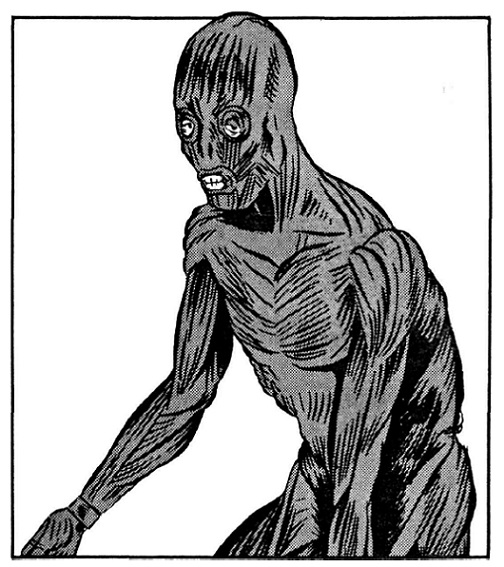
God, eyelid muscles are just the worst.
However, of all the monsters in this chapter, skinless are probably the most dangerous – not because they’re deadly in combat (though they are) or they have shamanic powers (though many do), but because they combine both of those with a human intellect. Skinless lack, well, skin; their muscles are exposed to the open air and encircled by pulsing arteries and veins, and many have bags of glistening fat that hang off their bodies
 . Skinless remain as smart as they were in life after they transform (though they do tend to develop [usually controllable] singular obsessions) and they still have all the physical needs of a human being, unlike almost every other monster on the list. However, the probably need more iron because their bodies leak a steady stream of blood from exposed muscle and veins. This leads to a slow, constant source of pain that makes them eternally irritable and resentful of more comfortable humans.
. Skinless remain as smart as they were in life after they transform (though they do tend to develop [usually controllable] singular obsessions) and they still have all the physical needs of a human being, unlike almost every other monster on the list. However, the probably need more iron because their bodies leak a steady stream of blood from exposed muscle and veins. This leads to a slow, constant source of pain that makes them eternally irritable and resentful of more comfortable humans.
Skinless, again like humans, gather with other skinless and form social structures. They tend to gather around charismatic leaders who organize their troops in whatever method pleases them, often leading them in raids against human villages and sometimes trying to form vast skinless empires. In the warm(er) months, these communities live in makeshift camps and hunt in the surrounding forest; in the winter they go into caves and hang out near fires because cold makes them sluggish and exacerbates their pain. Skinless groups often have access to shamanism, whether obtained from the god that killed them or taught and passed down by other shamans (they are the only group in the Madlands that openly teaches shamanism), but they do have a unique form of magic – skinning. Skinless can capture humans and conduct a ritual in which they ritually skin their victim, taking their epidermis whole. If they manage not to go into shock (easier in-game than in real life) they become a skinless! Yay
 ! A slightly altered version of the ritual can take the victim’s skin off for use as a disguise before the victim goes skinless/dead; however, if the person dies, the skin melts into disgusting goop, and someone who goes too long before completing the skinless transformation in this way will go crazy from pain.
! A slightly altered version of the ritual can take the victim’s skin off for use as a disguise before the victim goes skinless/dead; however, if the person dies, the skin melts into disgusting goop, and someone who goes too long before completing the skinless transformation in this way will go crazy from pain.
Though some skinless are born this way, most are either created by the gods (their skin gets eaten off, burned off, magicked off, etc.) or through social dysfunction. Being too self-centered, whiny, or easily offended can turn a person into a skinless, I guess because selfishness is bad? I don’t see the connection. Those that fight skinless and make it back to the village might begin to suspect others are skinless in disguise, suffer psychosomatic pains, or start to think their skin is about to peel itself off of them and wander off.
Most monsters deal with individual issues, but skinless reflect the moral collapse of a community. A skinless community is the dark reflection of a Madlander village; cooperation is replaced by domination, prudence by heedless exploration of shamanism, creation by destruction. The foul acts of the skinless are a warning against any weakening of the bonds that hold Madlander society together.
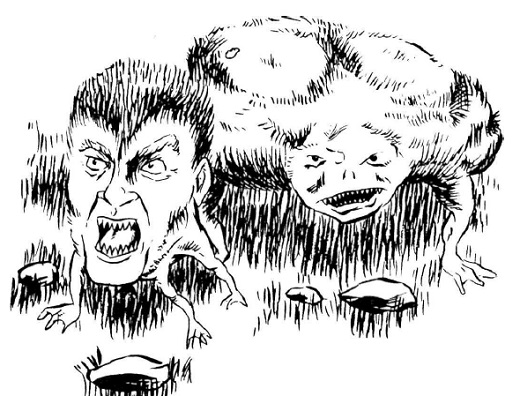
Wolverine’s healing factor finally went too far.
Soundless are called soundless because they move without making a sound
 ! If someone is torn to pieces by a god, those pieces will eventually form into soundless; if someone becomes too withdrawn and refuses to share anything with the community, they’ll start growing grey fur and eventuall
literally fall apart and scamper off into the wilderness. Each “individual” is actually six separate creatures: the torso, the head, and the four limbs; these are all equal parts of the colony and, unlike many monsters, targeting the head doesn’t do anything to the rest of the group. Soundless hunt humans, and they hunt in a pack; when they can catch a person unawares, they use one grown-in poison sacs to paralyze the victim and eat the poor fucker; bloated and sated, the group makes its way back to a lair to rest for a few weeks before they go on the hunt again. But what happens if you manage to kill a pack member (pack members can be killed more easily than other monsters)? Well then, that pack will hunt you down, paralyze you, and
replace the body part you destroyed with your own, giving the new pack member first crack at it
! If someone is torn to pieces by a god, those pieces will eventually form into soundless; if someone becomes too withdrawn and refuses to share anything with the community, they’ll start growing grey fur and eventuall
literally fall apart and scamper off into the wilderness. Each “individual” is actually six separate creatures: the torso, the head, and the four limbs; these are all equal parts of the colony and, unlike many monsters, targeting the head doesn’t do anything to the rest of the group. Soundless hunt humans, and they hunt in a pack; when they can catch a person unawares, they use one grown-in poison sacs to paralyze the victim and eat the poor fucker; bloated and sated, the group makes its way back to a lair to rest for a few weeks before they go on the hunt again. But what happens if you manage to kill a pack member (pack members can be killed more easily than other monsters)? Well then, that pack will hunt you down, paralyze you, and
replace the body part you destroyed with your own, giving the new pack member first crack at it
 .
.
Soundless in combat aren’t insanely tough; their chief threat is the fact that they automatically succeed at stealth checks and can paralyze you in combat (it takes weeks to full recover from it). Survivors of such encounters might feel like they’re being followed or like their bodies are about to actually fall apart.
Soundless represent subterfuge. A sneaky, dishonest person is a threat to their community as they hide and appropriate its resources for themselves. A soundless hunts men as a liar hunts resources; both can cost the village dearly in times of want
A weightless on a cloudy day.This is the laziest thing I've done in this review. Yet.
Weightless are the saddest and least threatening of all Madlands monsters. In the right light, weightless look exactly like ordinary people. In the wrong light, they are revealed as spectres with no ability to interact with the world. At any one time, a weightless can influence two senses but not the three others; you can see and hear them, or smell and taste them I guess. Except one of the five senses is touch, so
 . Some weightless go nuts and try to hurt ordinary humans, but most remain sane(ish) and only want to talk to others and be less lonely; sadly, Madlanders shun them because they can’t tell the difference and can’t trust them to tell the truth. Most weightless end up wandering the wilderness in forlorn depression, eventually seeking out a god to kill them (or at least turn them into another monster).
. Some weightless go nuts and try to hurt ordinary humans, but most remain sane(ish) and only want to talk to others and be less lonely; sadly, Madlanders shun them because they can’t tell the difference and can’t trust them to tell the truth. Most weightless end up wandering the wilderness in forlorn depression, eventually seeking out a god to kill them (or at least turn them into another monster).
Most encounters with weightless leave no psychological trauma in the encounterees, though some people might lose touch with one of their senses. Many weightless are created when a god completely obliterates someone, but philosophical types can accidentally enweightless themselves through the following line of thought;
- The Madlands don’t make any fucking sense.
- Therefore, the Madlands don’t exist
 !
!
- Therefore, I don’t exist
 !
!
- Therefore, my body doesn’t exist anymore
 .
.
Though philosophers aren’t necessarily as harmful as other monsters, unnecessary introspection can be. While a philosopher can contribute by discovering helpful new ideas (like a weightless can provide important information), they can also spread bad ideas (like a lying weightless) or just spend too much time thinking to contribute properly (like a weightless just floatin’ around the countryside moping). This sin isn’t as great and terrible as the others, but it still ain’t good.
Alright, the monster section of the chapter is finished, but there’s still more to Chapter 6 before we reach Chapter 7 (in my opinion, the climax of the book). There isn’t a whole ton more in there, though, so it should be a short update.
Next time: Did you know that seals can talk? And also cast spells?
BESTIARY GRABBAG
Original SA post GURPS FANTASY II: MADLANDS6.75 – BESTIARY GRABBAG
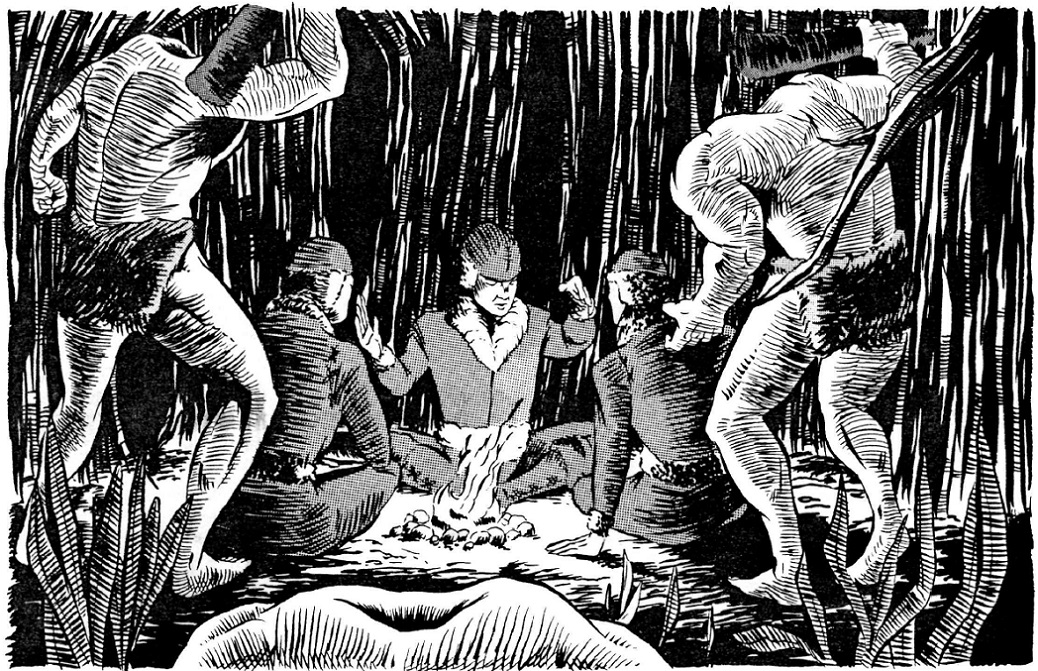
Dance before the power of my flaming crotch! Dance!
So, we’ve covered all the true Madlands monsters but there’s still stuff to go before we finish the chapter. Like mutants! Yes, they have mutants in a low fantasy setting, but not these mutants. Animals are as vulnerable to weird magical shit as humans, but instead of turning into one of a few standardized monsters every mutant is its own strange anime creature (“anime” was a typo, but it’s pretty fitting so it stays). Remember hauntings? If a particularly stupid monster decides to set up shop in one of them, it comes out pretty horrifying;
”GURPS Fantasy II: Adventures in the Madlands” posted:
Anything is possible: flying weasels, carnivorous rabbits with saber teeth, cyclopean wolves with poisonous breath or intelligent hornet colonies with hypnotic powers… Rivers are populated with monstrous fish: giant electric eels, char that act like piranhas and muskellunge that feed like sharks.

There are two given examples of mutant animals. The first is a rattlesnake with telepathy that just uses it to tell you your most secret desires. The other is a raccoon that likes to steal fish from drying racks and shoots fucking laser beams from its eyes. Fun!
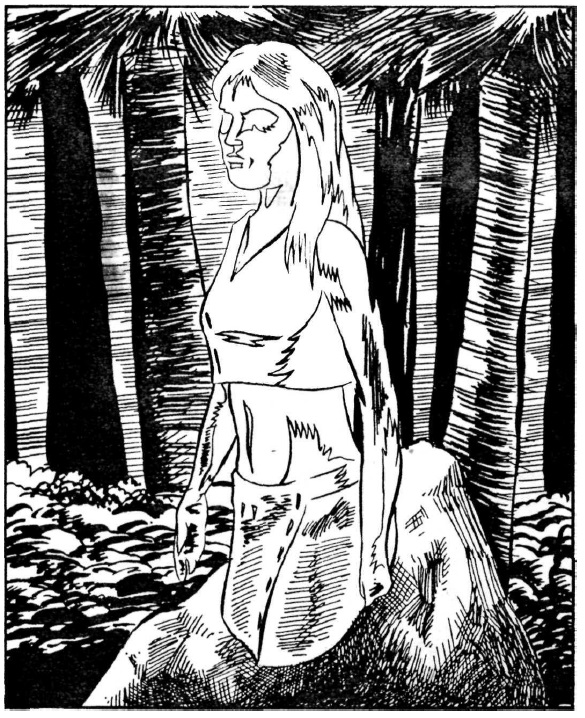
Man, I got way too drunk last night. Guys, what happened after I blacked out? Guys?
Those poor Madlanders who don’t get a proper burial and don’t turn into monsters turn into undead. Madlands undead closely resemble revenants; they gain special powers related to the opposite of their virtues in life (wisdom turns into irrationality, kindness into sadism, their flaws magnified (gluttons can unhinge their jaws like a snake, blowhards turn into banshees) their personalities in general (drunkards autocast aura of intoxication, storytellers gain hypnosis powers), or just whatever they need to start fucking people up. They also look the part, usually visually reflecting their deaths like a headless guy carrying his head Sleepy Hollow-style. Undead target people they were close to in life, try to kill friends or pursue desires left unfulfilled
”GURPS Fantasy II: Adventures in the Madlands” posted:
The subject of an old unrequited crush might be targeted for abduction and a fate worse than death.

Ghosts also exist. They’re much rarer than undead (though they can be left behind by anyone), only showing up in certain circumstances. Sometimes, they straight up don’t realize they’re dead; sometimes, they have some emotional tie to the world they can’t dump on the way to the afterlife; sometimes someone just thinks of them too much, or because some idiot named their kid after them which allows the ghost to possess the infant. They have supernatural powers undead-style with a weird and probably unintentional twist; the book tells you to make ghosts by removing all their physical stats and skills and dumping their point value into powers, which means Ug the village idiot can move mountains and the village’s wisest elder can throw around a pot maybe. Ghosts are, well, insubstantial and can’t be harmed, but they can only show up under very specific circumstances like times of day or weather conditions. How do you make a ghost go away? Good question!
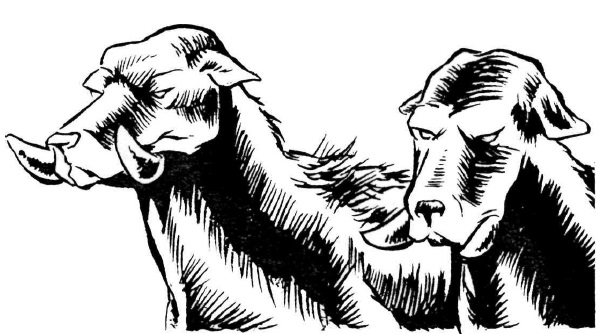
The pigdog, man’s worst enemy (except for everything else in the Madlands).
Shit That Isn’t Supernatural
The grab-bag of the grab-bag. The end of the chapter includes a bestiary of the Madlands (imagine Fantasy Canada) with some unusual notes;
- Porcupines are “sometimes heard whistling popular Madlander songs, usually slightly off-key”.
- Skunks have peacock-level beautiful feathers that would be very valuable if they weren’t attached to skunks.
- Wild boars are replaced ecologically by “pigdogs”, tusked canines that like to raid villages for their tubers. Everyone hates pigdogs.
Isn’t Zuutak described as a boar? How would Madlanders even know what a boar looks like? I don’t see evidence they exist in the Madlands in the rest of the book.
- Maybe one in six squirrels can turn their face vaguely human-looking as a defense mechanism. Madlander hunters, when not too startled to let them escape, kill them on principle.
- Wolverines eat iron ore to make their coats harder.
- Deer have patterns on their fur that change from generation to generation, and this generation’s pattern resembles something gnawing on a human ear.
- Mountain lions like to hang out with ghosts.
- Killer whales might be both intelligent and inherently evil, but they’ve never spoken to Madlanders so no one knows for sure. The seals swear it’s true, but the seals swear a lot of things.

Incidentally.
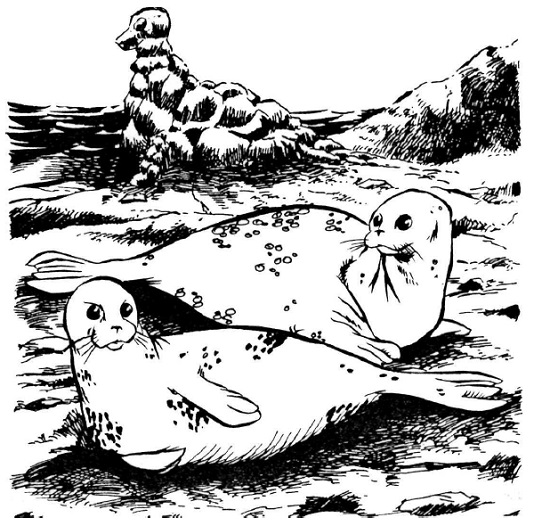
Honey, I know someone will buy your self-portrait, you just have to give it more time.
Some seals in the Madlands are just ordinary seals (barely worth mentioning), but other seals are fully intelligent sapient beings; Madlanders consider them straight-up humans as far as crimes such as murder are concerned, an honor non-Madlander humans don’t receive. Seals like to eat (they eat the same things that Earth seals do) and bask after a good meal (they like laying around in the sun so much they’ll kill hostile interlopers with bites from a mouth filled with sharp teeth). Short of those two things, seals like to talk; they like to talk and tell stories and tell jokes and especially make verbal contracts and double especially combine those last two. Though a seal’s word can be always be trusted by a human, it has to be their exact word; they love finding and exploiting loopholes in such agreements and like to do so in such a way that it humiliates their opposite number. If you try to argue against one, it will just continue to argue until either side gives up, and seals can go a couple weeks without eating so good luck. Such arguments among seals can last for said weeks until hunger finally gets to the loser.
Seals are individualists to their cores. They don’t oppose social relationships per se, but they rarely form permanent attachments; even mates only stay together during mating seasons, and seal cubs, creatures as intelligent as humans who need over a decade of socialization to function, only stay with their parents for two years. However, they have a powerful shared culture (presumably that’s how seal children are educated) that prizes humor, songs, and stories. According to the book, seals try to enter human contests in all of the above. They even create physical art (granted, stone sculptures of seals made by nosing rocks into piles). And part of this culture – a part they carefully conceal from Madlanders – is their use of Epic sorcery, a form of magic very different from the god-based shamanism familiar to Madlanders. Apparently nobody knows how the seals learned it and they sure aren’t telling. They can speak Soulless, though, so that’s probably how they got ahold of it. I’ll touch on the soulless at the end of the post.
I like this chapter. Though some monsters are less inspired than others (coughheightlesscough) almost all of them can be a monster of the week or help form the basis of a story arc. The ordinary Madlands animals, though, are probably my favorite part, as quiet and unobtrusive as they are compared to homicidal organ-skeletons and raccoons that shoot laser beams and mind-reading feet. Nothing quite conveys how weird the Madlands are better than encountering a squirrel that suddenly looks like a person or hearing a porcupine give a drunken rendition of a folk song. It’s just so beautiful

We’re almost at the end of the setting information. In page length. Not in post length. Oh, mercy, no. This next chapter has the exact same page count as the last but I’ll be lucky to get through it in three long-ass posts, as it’s so dense with information that I, by my estimation, can cut down its word count maybe to a third without distorting the text, whereas I could reduce a half-page to a paragraph here. The next chapter deals with the Soulless, the only Madlands monster not covered in chapter Six. They are not proper Madlands monsters, though. They are elves. They are also dwarves. And they are the most terrifying example of either I’ve ever encountered.
Next time: our elves are the worst elves
THE SOULLESS, INTRODUCTION
Original SA post GURPS FANTASY II7 – THE SOULLESS, INTRODUCTION
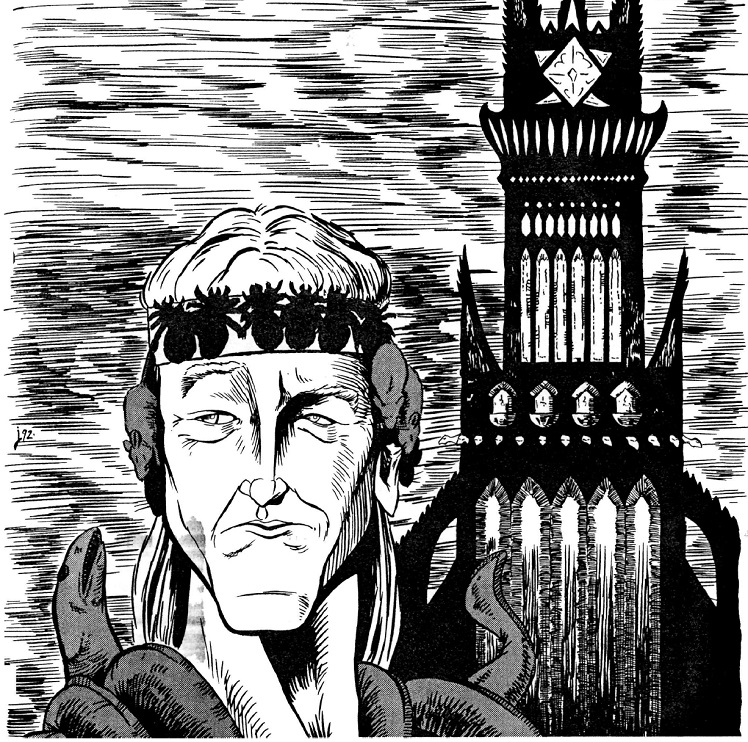
You ready to see what long-term immortality looks like? Too bad!
”GURPS Fantasy II: Adventures in the Mad Lands” posted:
The final group of "monsters" native to the Madlands is the soulless. Unlike the others, they are a genuine race, with their own language and highly developed culture. Too highly developed, in fact. Cursed with immortality, the soulless are trapped in cultural stasis, having exhausted every means of diversion centuries ago. This has made them decadent and cruel. To the Madlanders, they're unpredictable, frighteningly powerful menaces. From their own standpoint, they're victims of a cosmic practical joke.
To a Madlander, a Soulless looks kind of like a human. Their eyes are yellow and lack pupils; they have high, thin cheekbones, long, sharp noses, narrow heads, and narrow eyes; they’re usually a foot or so taller than an adult human male and maybe 20 pounds less; and their skin varies between any number of natural colors. They cannot die of old age, and so, with countless years of practice, they are so deadly in combat no Madlander can hope to outfight them and they’ve mastered magic even shamans don’t understand – however, they’ve also lost the ability to have children. They live in hidden ancient cities in the interior only accessible through seemingly-natural circles in the woods; rocks, trees, mushrooms and the like.
Sound familiar?

However, unlike your standard fantasy elfs, Soulless are vicious sadists driven to a human definition of insanity by boredom. While they were once human(ish), tens of thousands of years ago they did some ill-defined thing that granted them immortality, but tens of thousands of years is a little long for a single culture to last; their culture exhausted any creativity it had roundabout at least 10,000 years ago, declined precipitously, and reached rock bottom 5,000 years ago. Soulless cannot die; though they can be killed, any time they die they reincarnate in the form of an unfortunate Madlander baby (which sharp-eyed elders usually bash to death on the rocks outside the village) and eventually gain back their memories. And since they’ve invented everything new they could think of, there is nothing more to discover or learn or live for and they are bored. The Soulless, whatever they might say, want nothing more than to die. Unfortunately, the magical pact that gave them eternal life prevents this.
This leaves them a mite pissed off.
With all my harping on about how Madlands can be used for campaigns with little adaptation, even Laws acknowledges that eventually players will get bored of village life and start to space out. The Soulless are his answer to that. While the Madlanders have achieved a culture that can last forever in exchange for comfort and security, the Soulless have phenomenal cosmic power and nothing to do with it. When you think the players are decelerating, start dropping hints that something’s coming (What kind of hints? I don’t know!) and let them plunge their asses into the Soulless Metal Cities. When they’ve finally emerged, their characters will have changed irrevocably and the campaign will end naturally.
While I understand why something like this is included, as you’ll see, the Metal Cities are way too much for an ordinary character to survive, especially for anti-magic barbarians like the Madlanders. The Soulless are so wildly played up that it takes an insane amount of GM hand-holding just to get them through a session unharmed, and the separation of their two cultures is great enough that dead characters can’t easily be replaced. I can, however, see a campaign centered around a party of changelings who somehow miss the Soulless Patrol and grow up in the Madlands, only to eventually find their way to the Metal Cities and gradually regain their memories. But there’s no mechanical support for this and characters are left floundering whenever they get there. Naturally, there’s vanishingly little advice on how to GM Madlanders among the Soulless. Yay!
There’s a LOT of ground to cover with the Soulless, and I neither like the way the book presents it nor think I should skip over anything. Have a hapless, meandering introduction!
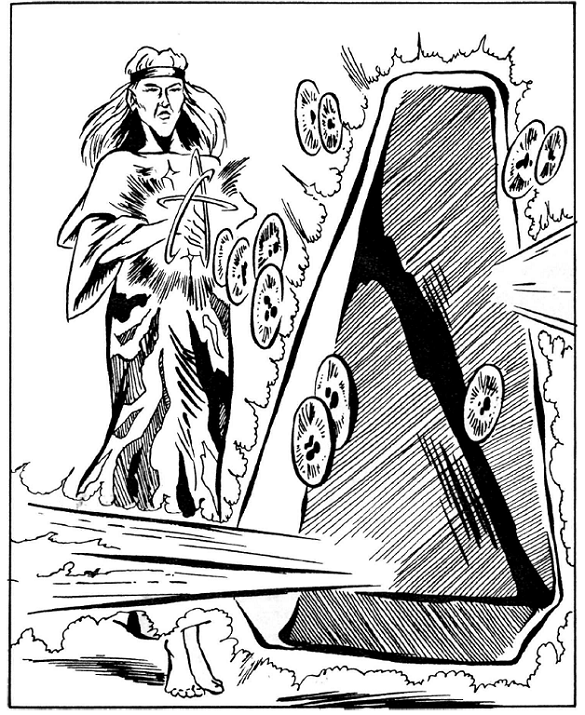
A hostile nephrite trapezoidal prism.
Once upon a time – and I mean a time, the Soulless can’t remember it because it was so long ago and their records are unreliable, but they think 14,500 or 22,700 years ago
 - the Soulless were a group of tribes divided from ordinary humans only by a “few minor anatomical differences” (:elf:) and an unpronounceable language. They lived a hardscrabble existence in the pre-gods version of the Madlands, which was at that time dominated by “a race of malevolent jade trapezoids.” What
- the Soulless were a group of tribes divided from ordinary humans only by a “few minor anatomical differences” (:elf:) and an unpronounceable language. They lived a hardscrabble existence in the pre-gods version of the Madlands, which was at that time dominated by “a race of malevolent jade trapezoids.” What
 ? This tribe, the Jyiuehyynkzd (see?) was oppressed by these “trapezoids” until one tribe’s princess, Oxlcyxowsyjys (
see?) reverse-engineered their sorcerous powers and used them to trick some otherworldly being into granting them immortality; over time, they outlived, outsmarted, and annihilated the “trapezoids” and established their own civilization. At this point, Soulless history begins.
? This tribe, the Jyiuehyynkzd (see?) was oppressed by these “trapezoids” until one tribe’s princess, Oxlcyxowsyjys (
see?) reverse-engineered their sorcerous powers and used them to trick some otherworldly being into granting them immortality; over time, they outlived, outsmarted, and annihilated the “trapezoids” and established their own civilization. At this point, Soulless history begins.
- THE FLOURISHING: The period after the advent of immortality, marked by the flourishing of soulless culture and the invention of everything they now hold dear. Once again, the setting math proves dodgy; though Laws calls it “a very long period in Soulless history”, if that lower estimate he gave is right, this period lasted maybe 2,600 years, rather short in Soulless terms. The other estimate leaves over 14,000 years in this period, which, holy shit.
- THE STAGNATION: The Soulless finally ran out of shit to come up with and just started repeating themselves. They grew steadily more bored and listless as time went on, a harbinger of things to come. Lasted maybe 1,000 years.
- THE DECADENCE: Desperate and afraid, they tried to destroy everything that made them great and replace the pride and glory of the Flourishing with serial arson. Lasted roundabout ¼ of the Flourishing, making it last either a measly 700 years or a more respectable 3,500. Time has erased any Soulless memories before this, though a few have faded and hazy memories from this period.
- THE REACTION: The Soulless decided to unfuck their civilization and partly succeeded; they rebuilt some parts of the Flourishing, but,
Soulless.jpg. Lasted 2000 years; most Soulless can think back this far.”GURPS Fantasy II: Adventures in the Mad Lands posted:
This period ended when the soulless discovered that they were now spiritually incapable of recapturing its purity, and that it was boring anyway.
- THE SWINGS: Attempts to recapture either the Flourishing or the Decadence, all of which failed more miserably all of seven and six times, respectively. They know it lasted 1,283 years, as all Soulless can remember back this far.
- THE PHILOSOPHY WARS: As every other cultural innovation died out, philosophers still managed to create new(ish) ideas to try and come to terms with their existence as immortal beings for millennia more. Eventually, though, even philosophy died out. The Philosophy wars started when a philosopher-celebrity named Llykzhkyjzhm (SEE?) declared philosophy was dead and had his philosophy buddies attack the audience en masse, sparking a series of conflicts that lasted 1,411 years until it grew too boring for the Soulless to continue.
- THE END OF HISTORY: With nothing left to do, the Soulless have dragged themselves along aimlessly since, unable to truly innovate or change their lives. This period began 5,589 years before the setting’s present. 5,589 years ago on Earth, Egypt was 4 centuries out from the first pharaohs and the Mesopotamians had just discovered arsenic bronze; according to the bible, Earth was less than 2 centuries old.

So, you may have noticed there’s a little bit of haziness in the historical record, despite it being written down and all. Why? Mmmmmagic!
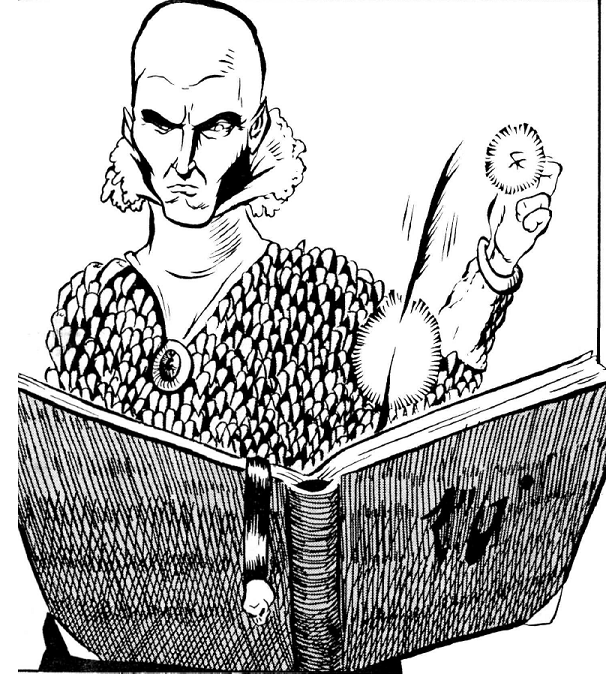
I gotta be honest with you, I forgot how to write.
Every last aspect of Soulless culture boils down, in some way, to magic. Their magic isn’t shamanism; in fact, they despise the gods as only Randian individualists can. Instead they use four unique schools of spellcastin’: Epic sorcery, which uses the greatest achievement of Soulless literature to turn literary analysis into a superpower; gem injection sorcery, which is, well, gem-fueled heroin magic; singing sorcery, which, guess; and sacrifice magic, which they stole from the trapezoids (seriously, what the hell?) and categorizes sacrificed Madlanders as animals
 . In fact, the Soulless consider sorcery the dividing line between intelligent beings and animals. Madlanders aren’t human to them (:elf:). This is a problem because, since they make literally
everything in their cities through sorcery, their history books are made the same way; and because sorcery can and does reflect the biases of the caster, history has been so distorted that they’ve lost any trace of their original culture. And, of course, since everything’s made by magic, all Soulless have lost the ability to craft anything by hand or take pride in it. The only exception is the Epic, which Soulless value too much to risk corruption. It’s telling that, as much as they want to reclaim their past glories, they still rely on their centuries of magical experience to try and reclaim it.
. In fact, the Soulless consider sorcery the dividing line between intelligent beings and animals. Madlanders aren’t human to them (:elf:). This is a problem because, since they make literally
everything in their cities through sorcery, their history books are made the same way; and because sorcery can and does reflect the biases of the caster, history has been so distorted that they’ve lost any trace of their original culture. And, of course, since everything’s made by magic, all Soulless have lost the ability to craft anything by hand or take pride in it. The only exception is the Epic, which Soulless value too much to risk corruption. It’s telling that, as much as they want to reclaim their past glories, they still rely on their centuries of magical experience to try and reclaim it.
There’s an undercurrent that runs through this chapter that never gets directly remarked on, but I think it’s wildly important. The Soulless themselves, though they believe themselves completely spent and creatively dead, are still intelligent beings with the ability to create new things. However, they are so submerged in their stagnant culture that they can’t. For instance, the Soulless, being radically individualist, regard any kind of divine being with loathing and disdain (and abject fear, though they’d never admit it). They consider any kind of divine being either an impostor or something actually below them, and they deal with the extradimensional beings they sometimes encounter as lesser creatures. The thing is, only such creatures are likely to finally kill them, but the Soulless can’t push past their cultural prejudices to consider it. Dying, or at least being changed into something new and interesting, is as easy as walking outside and thinking about Bett Agwo really hard – they’re so desperate for something new that they’re willing to do shit like going through drug withdrawal multiple times just for the sensation. They still can’t even consider it. I mean, apparently Soulless killed by gods come back as changelings instead of monsters, but you’d think they’d embrace divine alteration
 .
.
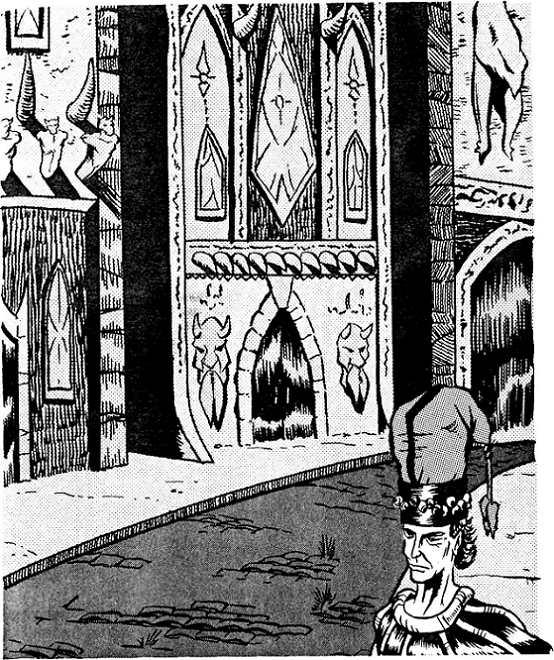
See? I told you they were dwarves!
The Soulless actually deeply dislike the Madlands; divine contamination makes their spells go frequently awry and you can’t have that. Instead, they live in three “Metal Cities”, Kzowozymyzkz, Fyzkwyzkozpoza and Xymsdykyhjyzklz ( SEE? ) buried deep under the earth somewhere in the Madlands. You can only get to them through fairy-circle equivalents described above (:elf:), and once you enter you reach the Street, which, well, there’s only one Street in each city connecting roughly 5,000 inhabitants. Instead of it being, like, an actual street, the Street is a nebulous path between all the city’s buildings determined by the walkers. If you’re psyching yourself up for a duel to the not-death, the street is a narrow pathway surrounded by spikes with impaled people on them. If you just got magilaid, the Street is broad, the gem-plated birds are singing, and everything looks as pretty as it can, because it can’t by human standards. Soulless inclinations towards the overwhelming mean their buildings (which show up whenever the walker wants them to) are offensively gaudy and feature Doctor Who interior construction; this is another way Soulless show off, as they can set their houses to pop up as people stroll around or even force their buildings onto the streets. By the way, as Soulless are basically autonomous, there are vanishingly few public buildings, only excepting public entertainment centers.
Finally, a note on Soulless language. Their language is so old and overdeveloped that even prepositions can last a dozen syllables and ordinary roots last several times that, not counting the dozens of modifiers used to communicate the slightest variations in meaning. The average Soulless word has 29 syllables
 ! Names are usually half-again as long
! Names are usually half-again as long
 ! The longest word in their lexicon is the direct translation of their name for themselves, with
8,906 syllables
! The longest word in their lexicon is the direct translation of their name for themselves, with
8,906 syllables
 ! The book straight-up tells you, when it comes to pronunciation, to just fake it; the suggested method for coming up with Soulless words is to mash the keyboard for a couple seconds and edit the result to fit the spelling scheme.
! The book straight-up tells you, when it comes to pronunciation, to just fake it; the suggested method for coming up with Soulless words is to mash the keyboard for a couple seconds and edit the result to fit the spelling scheme.
Dyfzhzygrizhnygok!

Olzhdkygnogaopgynpagynropa!

Afylgnoiufbyygagnalniuzhyygdlyal!

In practical use, you shorten these to a few syllables or use a nickname instead.
Next time: fashion means strapping live dogs to your ankles!
THE SOULLESS, CONCLUSION
Original SA post GURPS FANTASY II7.5 – THE SOULLESS, CONCLUSION
Hey there, folks! Been a while, hasn’t it? …Nearly a year and a half? Christ. Anyway, if you want to catch up on what exactly the Madlands are, or just to bring anti-magic barbarians, organ-skeletons, and malevolent divinities that are also the cast of Winnie the Pooh into your life, go here. Right now, I’m just going to assume you either know where we left off (on sadist elves) or you’re going back to familiarize yourself. In the meantime, have a skull hat!
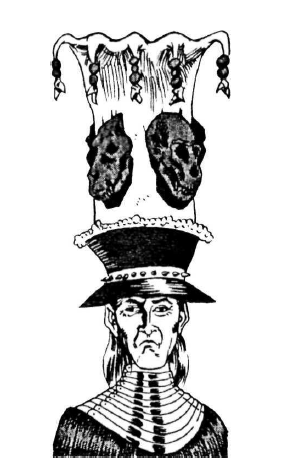
Fashion!
Everywhere in the Metal Cities, the climate is a perfect room temperature, so there’s no need to wear clothes. The Soulless do so anyway, though, because it gives them something to do and it gives them a way to one-up each other. Modern Soulless attire makes no goddamn sense on purpose. There used to be coherent fashions but they’ve long since run through every possible combination (there’s an extensive sidebar that covers this progress in detail, but it’s not worth describing centuries of pantaloon development here) and just wear whatever they want. Because they are Soulless, “whatever they want” is usually weird. Rather than try and sum up Soulless fashion, and because nobody can stop me, I’m just going to quote this section in full:
GURPS Fantasy II: Adventures in the Mad lands posted:
One might see a woman with a four-foot hat in the shape of a whale, studded with diamonds and sequins. She wears a velvet top embroidered with gold threads in a pattern that continually shifts depending on the mood of the onlooker. From the waist down she's clad in flowing pantaloons with horizontal stripes in orange, purple, and yellow. Each stripe smells of a different fruit: tangerine, grape, and lemon. Her boots are made from magically transformed live pigdogs; with each step they howl in agony.
Walking with her is a man wearing a leather headband. Attached to the headband with ultra-thin platinum chains are a half a dozen toucans, who flap about and occasionally fight with each other. Every time one of them pecks out another's eye, the soulless magically heals it. His torso is bare, but the skin is pierced dozens of times with rings of obsidian. He wears a kilt of panther skin that periodically bursts into purple flame. He has enormous platform shoes, one of them in black leather, the other of sandstone.
Slightly behind her is a woman covered completely in a white linen jumpsuit, which includes a mask with ruby-lensed eyeholes. Following her is another wearing Togethian-style armor made of ice, and then a man dressed from the waist down in crimson silk, and from the waist up in writhing eels.
Theater! The book doesn’t say much about Soulless theater, just that it’s popular and tends towards outrageous spectacle. However, in order to spice up the occasional death scene, a play might switch out a Soulless actor for a hapless human for the sake of verisimilitude. Sometimes they’ll actually spare a human who gives an exceptionally moving performance, though this is only so they can use them later for something even more dramatic. Plot hook!
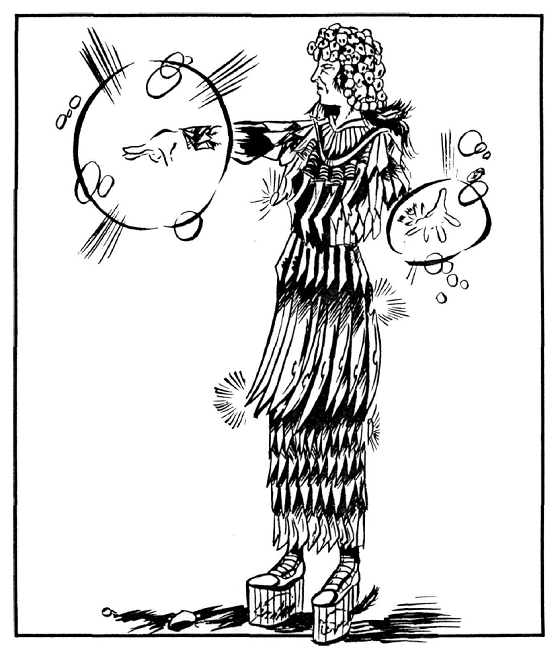
Going to war in dress clothing is the peak of sophistication.
Soulless don’t die of natural causes; old age can’t kill them, which is part of the issue, but disease or deprivation don’t hurt them either. You can still come pretty close to killing one, though. Whatever else their bodies can do, they aren’t inherently tougher than a human; if you can get past their defenses (a tall feat) you can strike them down like anybody else. However, if you do pull it off, instead of dying, the Soulless’s, well, soul flies out into the Madlands and enters the next fetus someone conceives. That child is a changeling, and if the Madlanders figure it out, they’ll kill it on the spot. The book describes changelings as visibly different from ordinary human children, if easy to confuse with them; the book doesn’t make this explicit, but it’s probably those “minor anatomical differences” (i.e. they are elfos) coming to the fore. At first, changelings act like normal children, but when they enter Elf Puberty, their “fiercely individualistic nature” asserts itself and other Soulless start being able to track them down. At this point, they (apparently without exception) experience one of three fates: their friends come looking for them and start to fuck up the village, only stopping when the changeling either agrees to go with them or a villager tries to negotiate with them by holding the changeling hostage (apparently this sometimes works, even after the Soulless have the kid and no reason to respect their promises); the same thing happens but it’s the kid’s enemies find them first, in which case they torture the changeling because
 ; or they Fuck You Dad their way out of the village and stumble towards the nearest Metal City until they trip through one of those fairy circle entrances. In any case, eventually somebody else cast a spell that awakens their memory and they are back to their sweet old selves again. Do they keep their memories from their changeling childhoods? Do they care about them? Do they affect their personalities later on? Good questions!
; or they Fuck You Dad their way out of the village and stumble towards the nearest Metal City until they trip through one of those fairy circle entrances. In any case, eventually somebody else cast a spell that awakens their memory and they are back to their sweet old selves again. Do they keep their memories from their changeling childhoods? Do they care about them? Do they affect their personalities later on? Good questions!So, at the beginning of last paragraph I mentioned how Soulless can die from violence, but haha good fucking luck killing one. The fuckers had millennia to perfect combat and it shows. Without going into system details, a Soulless on hits almost every swing and dodges almost every attack, invariably possesses magical weapons and armor (as visually bizarre as the rest of their culture, though they do tend towards highly decorated traditional melee weapons instead of stranger shit), and can cast healing and stamina-restoring magic enough to stretch combat out indefinitely. Don’t fight Soulless. Any fights, duels, and brawls last until somebody at last fails a roll and takes some damage, usually admitting defeat. Sometimes, instead of settling their disputes like gentleelves on the battlefield, the Soulless will take each other to court, in which case they argue circles around each other forever, usually resulting in suits and counter-suits that can last for decades. There’s little in the way of a concrete Soulless legal system, just an endless maze of laws and counter-laws that Soulless use to fuck with each other. Like everything else in Soulless society, it’s all a form of entertainment.
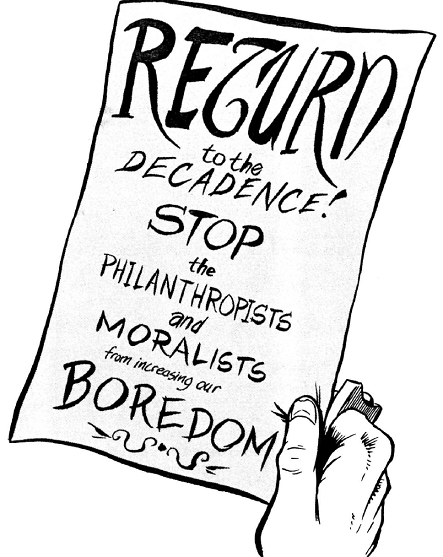
That isn’t Soulless writing! Oxlcyxowsyjys and the jyzuehyynkzd would be ashamed!
After telling us in detail how unplayable the Soulless would be, the book gives us rules on how to play them
 . All Soulless have extremely high stats, know every skill that isn’t setting-restricted to a degree beyond what’s normally achievable for character, know a shitton of spells in their chosen magic school (we’ll get to those schools next chapter), and generally just are shenanigans. Estimating from the given numbers, a Soulless character has maybe 550 character points worth of stats, advantages, etc., not counting skills, which if counted out would probably add a few hundred more. In the GURPS 4th Edition corebook, an average starting character has 100 points to spend. A Soulless has double that to spend on base stats alone. This is definitely not meant to be something players use, just a GM looking to represent the Soulless as anything other than GM fiat. Not that it matters, since they’ll outshine any PC anyway.
. All Soulless have extremely high stats, know every skill that isn’t setting-restricted to a degree beyond what’s normally achievable for character, know a shitton of spells in their chosen magic school (we’ll get to those schools next chapter), and generally just are shenanigans. Estimating from the given numbers, a Soulless character has maybe 550 character points worth of stats, advantages, etc., not counting skills, which if counted out would probably add a few hundred more. In the GURPS 4th Edition corebook, an average starting character has 100 points to spend. A Soulless has double that to spend on base stats alone. This is definitely not meant to be something players use, just a GM looking to represent the Soulless as anything other than GM fiat. Not that it matters, since they’ll outshine any PC anyway.GMing Soulless advice! A sidebar on the last page of the chapter sets out three primary mental distinctions between the Soulless and Madlanders: they don’t see humans as “human,” more like talking chimpanzees, and could not give less of a shit about their opinions; they do anything they think might spark some emotion in them, meaning you can’t rely on them doing things that make sense; and they are all so goddamn old that the present feels like an eyeblink to them. This is why their language is so insanely
 ; they have so much time to talk to each other that they’ve refined their vocabulary till it represents every concept they can think of in exacting detail. The GM is specifically advised to have fun with Soulless conversation; the term “thicket-like speech patterns” comes up here. It’s possible for there to be a good Soulless, but they are going to be very rare, very far from anything interesting, and still so powerful that them showing up more than once in a while will turn the campaign into the Soulless DMPC Action Hour with the PCs playing supporting roles in their own game. And if a player gets access to a Soulless character they turn into Immortal Wizard Drizzt, so don't do that. The book does provide a hook having to do with how the seals learned Soulless sorcery, though, so that’s nice.
; they have so much time to talk to each other that they’ve refined their vocabulary till it represents every concept they can think of in exacting detail. The GM is specifically advised to have fun with Soulless conversation; the term “thicket-like speech patterns” comes up here. It’s possible for there to be a good Soulless, but they are going to be very rare, very far from anything interesting, and still so powerful that them showing up more than once in a while will turn the campaign into the Soulless DMPC Action Hour with the PCs playing supporting roles in their own game. And if a player gets access to a Soulless character they turn into Immortal Wizard Drizzt, so don't do that. The book does provide a hook having to do with how the seals learned Soulless sorcery, though, so that’s nice.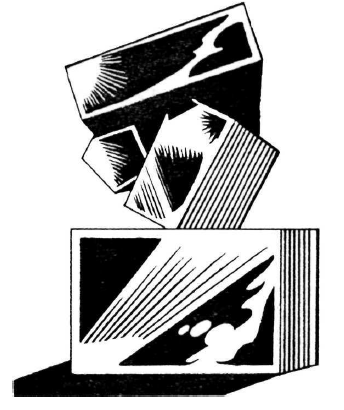
Have some unrelated art!
The Soulless, in my opinion, are both the most interesting and most frustrating part of the book. These are some of the weirdest elves I’ve ever encountered, that’s for damn certain, and reading about them is a pleasure. But I can’t imagine a way to work Soulless into a campaign without mental backflips. They are so far beyond PCs that it’s difficult to even interact with them, their culture is already hard to understand without stacking it on top of another alien culture in the Madlands, and the mechanics associated with them (i.e. sorcery, which I’ll cover next chapter) are the pinnacle of extraneous design; there’s four unique magic systems, each with its own spell list and conditions, and all of them will not matter in any game since it would take PCs beyond their reasonable lifespan to even get started learning them. This chapter, is great as it is, is GM entertainment, like reading many Planescape sourcebooks. Who the hell ever goes to the Quasi-Elemental Plane of Dust?
It’s still a fun read.
Next time: Don’t inject crush diamonds into your veins, kids!
MAGIC
Original SA postJoe Slowboat posted:
What I'm getting from soulless fashion is that they have the same style sense as MMO players who have gotten extremely bored but can't bring themselves to stop playing. Which is pretty much the Soulless condition.
Got it in one. Speaking of maxed-out classes!
GURPS FANTASY II
8 – MAGIC
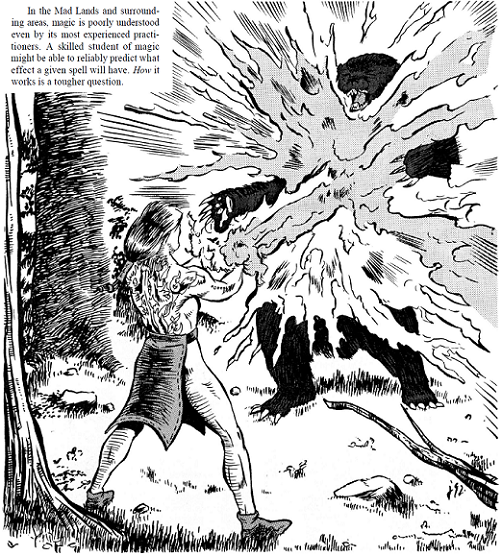
Fucking what why holy shit i thought this was a low fantasy setting
Standard GURPS magic, like standard GURPS everything, is a strictly regimented system running off spells that function like separate skills, the caster’s stamina, and ambient mana. Madlands magic works off the same base system but uses two very different approaches – shamanism and sorcery, the first of which comes from the gods, the second from various Soulless magical schools. Since I just finished writing up the Soulless, I’ll do sorcery now, even if the book puts shamanism first. Keep that theme going.
The book defines sorcery as any magic system that doesn’t rely on drawing power from the gods, but though it mentions other forms of magic, the only non-divine magic systems presented in the book are called Singing, Sacrificial, Epic, and Gem magic, and they all come from Soulless culture. All Soulless know one of these schools. You can learn more than one, but they require different mindsets and you have to switch between them; since being without magic in Soulless society is almost suicide, most don’t bother trying. Any Soulless can use just about every spell in their chosen school, but characters have to learn them individually; fortunately, every spell is symbolic with multiple, possibly overlapping uses, so even one spell can go a long way.
Sorcery, at least in the Madlands, dates back a while, possibly to the prehistoric jyzuehyynkzd (
 ) and their religious rituals (as much as modern Soulless would deny any religious connection), but it definitely arrived with those trapezoids, who used animal/human sacrifice to power their spells. When they overcame the trapezoids by stealing that magic, the newborn Soulless untangled magical principles from those rituals to turn old ritual chants into spells. From there, someone invented gem injection magic and society fought the War on Magic Drugs for a while, and later, someone else discovered Epic magic when
) and their religious rituals (as much as modern Soulless would deny any religious connection), but it definitely arrived with those trapezoids, who used animal/human sacrifice to power their spells. When they overcame the trapezoids by stealing that magic, the newborn Soulless untangled magical principles from those rituals to turn old ritual chants into spells. From there, someone invented gem injection magic and society fought the War on Magic Drugs for a while, and later, someone else discovered Epic magic when“GURPS Fantasy II: Adventures in the Mad Lands” posted:
One reader became so passionately involved in his section of The Epic that he caused a rain of acid-spitting purple bats.
Important note: sorcery doesn’t have set effects for each spell. It’s up to the caster (read: PC or GM) to decide exactly what the spell does. Instead, each spell functions as a skill that allows its user to invoke effects along some theme determined by the spell usually with the expenditure of a little stamina.
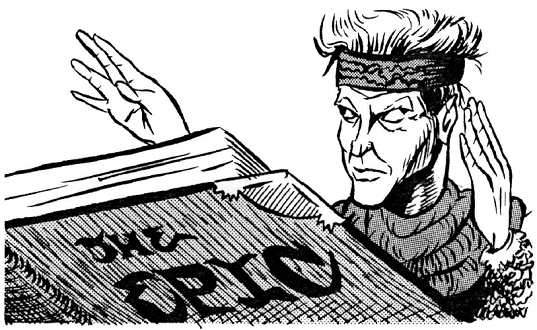
Pictured: not actually a spellbook.
The Epic (always capitalized) is the highest work of Soulless literature, revered by almost every not-elf. Consisting of 14 volumes totaling 239 pages and telling the story of people with names like Dyjyfl, Vyblh, and Kydlyv, it’s the only work of art they actually copy by hand (though most of them memorized it thousands of years ago). It is in fact so revered that many Soulless can actually use it to cast spells. Incidentally, its writer, Yrrdisvibyf, wrote it over such a long period that the book compares the linguistic evolution over its course to that between Beowulf and TS Eliot, but never finished it; he looks down on Epic magic practitioners since he practices Singing sorcery and hides from fans/Epic mages looking for nonexistent insights into the text.
Fucking hell, Soulless names.
Epic sorcery casts spells by “understanding” some random line, chosen by the GM or some other means not directly involving the players (“The student can't choose which line he will suddenly understand”). You should pull these lines from any archaic poetry work that seems appropriate, though
“GURPS Fantasy II: Adventures in the Mad Lands” posted:
If the playing group contains any English majors, the works of well-known poets should be avoided.
Unlike most other schools of sorcery, there is a place where you can actually learn Epic sorcery; the Critical Academy, an organization that moves cities every five years (one of the only times the book mentions how different cities interact) and theoretically practices literary criticism on the Epic. It’s been so long since anyone had a new insight that the Academy’s turned into a nest of academic infighting that would make any prestigious institution proud. However, if a character DOES go to the Critical Academy, the scholars will fall over themselves to teach them. Interestingly, the book mentions Academics stealing students from each other in the past, implying that outsiders have come by to learn sorcery before in enough numbers for patterns of treatment to emerge.
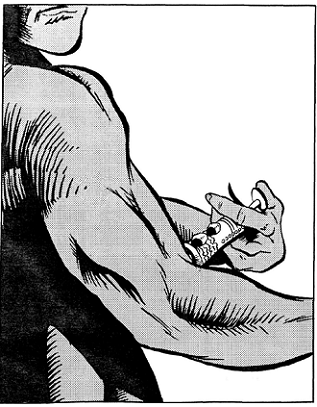
I wasn’t joking about heroin magic.
Next up is Gem Injection sorcery, which, well, casts spells by injecting crushed gems. Into your veins. With goddamn syringes. Or, at least, they use the sensation of injection (an intense body high) as a focus. Each type of precious or semiprecious stone has a different effect when injected based on the metaphysical significance of that stone; garnets, say, control probability and pleasure, while quartz affects illusions and perception and turquoise is associated with rotting and dead shit. I’m nearly certain that’s what turquoise is associated with in real life. Gem injection is addictive and can’t be used to make more gems (diamonds can generate specific gems in a pinch, but they can’t make them economically). This means that, in a post-scarcity society, gem injectors are the only ones who need things they can’t make, which means they have to grovel in front of other sorcerers until they make them more gems, which, them being Soulless, means they’ll fuck with them mercilessly before parceling out a fix. Why would people as obsessively individualistic as the Soulless subject themselves to others like that? Good question! Unlike lots of good questions in this book, this has an answer! While most types of sorcery are intellectual in nature, gem injection gives Soulless a reliable physical high even after all these years have dulled most sensations; plus, it doesn’t seem to affect a Soulless’s mental capacities, aside from gem reliance it’s just as potent as every other form of sorcery, and the body-wrenching sensations of breaking the addiction followed by the ecstasy of shooting up again is high entertainment.
Also it uses the Chemistry skill as the
 skill for controlling dosage and time-release, but the Chemistry skill is setting-restricted. Oh well, whatever.
skill for controlling dosage and time-release, but the Chemistry skill is setting-restricted. Oh well, whatever.Learning sorcery is a trial. Soulless, according to the book, see the ability to practice sorcery as the dividing line between people and animals, so a Madlander might gain some acceptance in Soulless society if they find a teacher. However, since no one’s taught a new sorcerer in ages (what about Epic magic students as mentioned above? Good question!), they've forgotten how to teach and will put students through endless trials. You can also learn through textbooks, but those that still exist are buried in trash heaps or used as door stoppers so good luck finding usable ones. The GM is advised to make seeking out a way to learn sorcery a part of the storyline so the PCs don’t spend their sessions floundering while failing to learn anything.
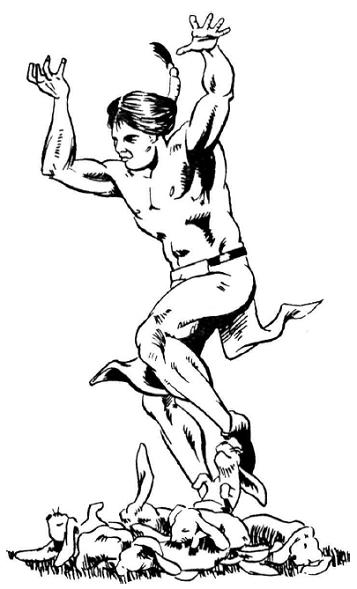
The missing link between shamanism and sorcery, probably.
Next up is Sacrificial sorcery. The
 jyzuehyynkzhd stole this from the weird trapezoid things that tried to destroy them before they returned the favor. So, you can probably guess how Sacrificial mages get their power, but the end product is a bit different; one sacrifice is all you need to get full access to that animal’s portfolio and you can cast spells with it indefinitely (as long as you don’t run out of energy); on the other hand, if you use one sacrifice for too long and for too much, you’ll experience personality bleed, which can suck if you killed a maggot, a human, or a Soulless.
jyzuehyynkzhd stole this from the weird trapezoid things that tried to destroy them before they returned the favor. So, you can probably guess how Sacrificial mages get their power, but the end product is a bit different; one sacrifice is all you need to get full access to that animal’s portfolio and you can cast spells with it indefinitely (as long as you don’t run out of energy); on the other hand, if you use one sacrifice for too long and for too much, you’ll experience personality bleed, which can suck if you killed a maggot, a human, or a Soulless. And yes, all of those are legitimate sacrifices.
Different sacrifices have very different effects, many of which represent biases in Soulless culture. For instance, sacrificing cougars, which allow you control over animals, grants you the ability to command humans – if you can’t cast magic, Soulless don’t count you as a person. Human sacrifice does give you the power to manipulate emotions, so hooray for that
 ! Be careful with that though,
! Be careful with that though,“GURPS Fantasy II: Adventures in the Mad Lands” posted:
since the resulting personality shifts dredge up abominable feelings like compassion, altruism and love.
There’s an entire two sidebars on the mechanics of sacrificial victims here which I won’t cover because
 .
.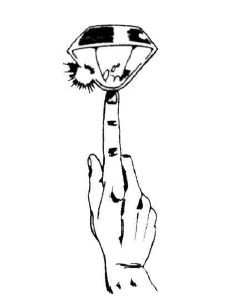
haha fuck you injectors
Singing sorcery! Though it’s practitioners like to pretend it’s the oldest and most authentic magic style out there, they (probably, they’ve all forgotten the details by now) invented them by studying that trapezoid magic, working out the base principles, and grafting them on to their old

Rivalries! Being Soulless, all Soulless look down on other schools and consider their school the best possible type of magic. To sum up: Epic sorcerers consider themselves the most in touch with their Soulless nature, while the singers are dreadfully out of touch and sacrificers and injectors are just so gauche; injectors love how physical their magic is, and consider Epic mages simpering dilettantes, singers prudish snobs, sacrificers gross sadists, and all of them ungenerous assholes who just won’t give them any gems come on man I’m jonesing and my dealer doesn’t get back till next Tuesday come on I know you’re carrying; sacrificers think of themselves as brave individuals in touch with reality while other sorcerers hide behind books, drugs, or folk music; and singers identify with the foundation of their race, with the other schools either trying to replace ancient tradition with literary analysis, falling into emulating their former oppressors, or defiling magic by turning it into a physical thing instead of their perfect, cerebral, boring favorite school.
This is like well over half the chapter. We still have shamanism and other, more distant magic systems to cover before hitting the GM advice section and sample village and finishing the book. Maybe two more posts.
Next time: Christ, these powers are really on the nose
MAGIC, CONT.
Original SA post GURPS FANTASY II8 – MAGIC, CONT.
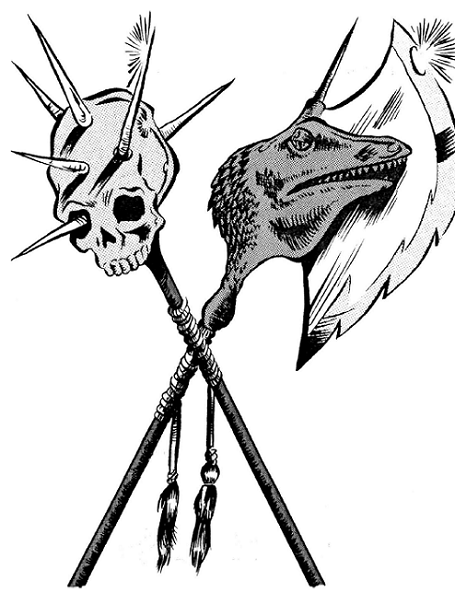
Shamans don’t fuck around.
Sorcery is a cerebral, refined art that relies on reason and cleverness to get results. Shamanism, on the other hand, is as unpredictable as the gods themselves. There are a couple of ways to get access to shamanic powers. The first and easiest/shittiest is by coming too close to a god and not dying; sometimes, this encounter will open a “mystic channel” to the god in question instead of just fantasy mental illness. The newly-created shaman has no way to dump this shit: they are stuck with it and just have to deal (i.e. go nuts). These folks usually end up with just one power. Others learn their magic from other shamans somehow, often forming a dysfunctional social network with each other; these folks are usually exiles or the overly curious, and they tend towards learning multiple spells. Either way, their powers come from propitiating the gods and carrying out their will in the world, in exchange for which they can blow people up and talk to thistles until their bodies give out.
Except it doesn’t work that way. In reality, the gods couldn’t give two shits about their “followers” and probably aren’t even aware of them in the first place. Shamanism runs off the perception that the shaman is in one way contact with their chosen god/s. That perception lets them tap into the ambient magic that fills the Madlands (I mentioned in the last post how GURPS magic utilizes mana concentration in the area; the Madlands’ mana is powerful and really disorganized thanks to the gods). If the shaman realizes this, their powers stop working – sounds like a good way to dump your shamanic powers and go back to being an ordinary anti-magic barbarian. Unfortunately, according to the book, shamans very rarely realize this, which sucks for them. Too bad! Your life is over.
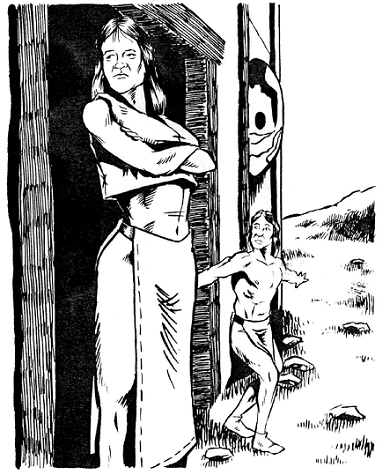
What the fuck is going on in this pic? Is that an adult? Why do they look the same?

Nobody likes shamans. Madlanders, naturally, know that shamans are inherently evil and fuck them. The book even provides you with a list of standard ways that Madlanders look for if they suspect someone’s a shaman. In theory, it’s possible to play a shaman that isn’t an enormous asshole, but a combination of prejudice and the inherent unpredictability of anything having to do with the gods makes that pretty tough. Shamans can sometimes hide in villages for a while, though, especially ones seeking power instead of being god-touched. These folks often form networks connecting shamans across multiple villages with more knowledgeable, likely previously exiled travelers. They tend to melt down and turn against each other, though, because, well, fuck shamans. Cultural biases don’t stop applying even when you’ve found yourself caught up in them.
The book provides rules for creating and playing shaman characters. It’s probably a bad idea. Shamanic powers, as far as I can tell, aren’t inherently corrupting or anything, but since being a shaman will get you kicked out of any community if you’re found out and shamanic powers fall victim to the same GM fuckery that Wish spells often do, shaman characters are usually boned. Either way, it’s expensive in character points to buy access to magic that might fuck you over at any time. Don’t bother.
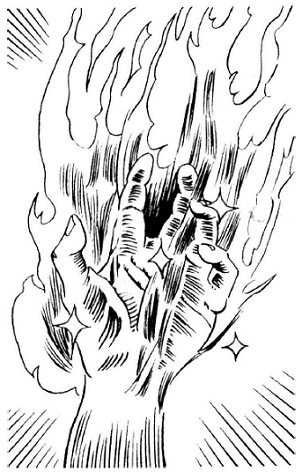
SHINING FINGAAAAAA
Shamans get their spells at unpredictable levels of power, cost unpredictable amounts of stamina, and have unpredictable effects – license for the GM to fuck with you, basically, whether characters are shamans or not. You know how the gods of the Madlands are Winnie the Pooh characters in disguise? And you know how I said shamanic powers are on the nose?
GURPS Fantasy II: Adventures in the Mad Lands posted:
Bounce (TiggerGakox Pezep,KangaKikavo Vo). Allows the shaman to leap high into the air and land far away without suffering damage (unless the spell fails, of course). The shaman can also use this as an attack which sends victims shooting skyward; when they fall, they don't bounce.
…
Detect Food (Winnie the PoohBubzavav,PigletZuutak). A very specialized, self-explanatory knowledge spell, dear to the hearts of its divine sponsors. Frequent use can substantially increase a shaman's need for food, as he mysteriously begins to burn calories at a startling rate. A possible explanation for this is found in one tale, in which a shaman with this power discovers that Bubzavav is magically stealing the food right out of his stomach.
…
Gloom (EeyoreBax Powu Kag). This allows the shaman to project a field of depressing emotion like that of the Moose.
…
Shrink (PigletZuutak). This allows the shaman to shrink in size. The easiest size to reach and maintain is that of a piglet - a foot and a half long, eight inches high. Experienced users of the ability get as small as a fighting beetle.
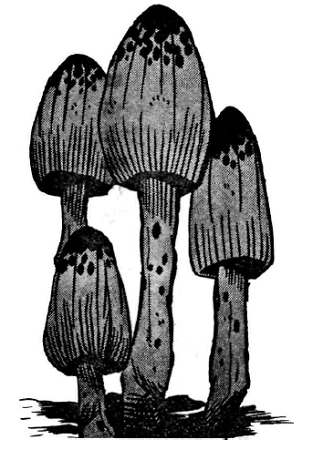

The last few pages of the chapter cover magic from other areas in scant detail, mostly how they relate to the Madlands. Apparently, the whole “magic works differently in the Madlands” thing applies to the rest of the world, too, just less so. The only magic in the Whiteness is sentient snow and it doesn’t leave the borders; the Northern Tribelanders, Mary Sues that they are, are shielded from harm by their
GURPS Fantasy II: Adventures in the Mad Lands posted:
“Cast Fireball At Municipal Guard On Council Day," for instance, or "Transform Pink Toad To 40% Silver Alloy."
Fucking Madlands magic. There’s a lot of interesting stuff here, but it’s buried far away from where players can access it and overly complex even if they manage to reach it. Also, the book lets us know at the beginning of the chapter that Madlands magic is deliberately descriptive instead of concretely defined to emulate the fantastical, ineffable magic of many fantasy novels. I mean, it succeeds at that, but there’s a reason D&D defines those powers, and they aren’t as tightly designed as those in many storygames. You just end up with an unstable balance between player omnipotence and oppressive GM control that doesn’t accomplish much. Oh well. At least it’s an interesting read (that describes this book as a whole).
Two more chapters, the GM advice section and a sample village, before the book is finished and I declare victory over this book.
Next time: I finish the book, reveal what comes next, and finally get to drop a secret I’ve been keeping for nigh on two years.
CAMPAIGNS AND SAMPLE VILLAGE
Original SA post GURPS FANTASY II9-10 – CAMPAIGNS AND SAMPLE VILLAGE
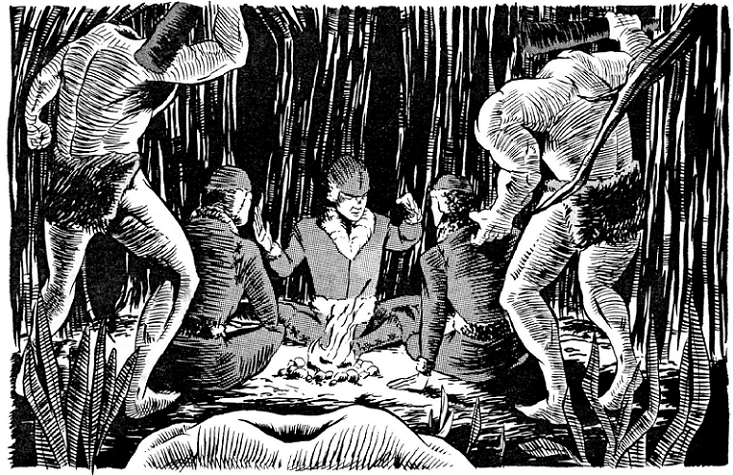
I love this picture so fucking much.
This post will be a little perfunctory – there’s not a lot of interesting meat here, other than character analysis in the village, and I’m unlikely to bother with plunging those depths.
According to the book, Madlands campaigns should focus on characters and character drama rather than some kind of overarching plot. It takes kind of a storygame approach; have the players draw up their characters, give them some introduction to Madlander society (it recommends a festival of some kind), and let them do their own thing. From there, try to follow the hooks they took until a trend emerges. Maybe half a dozen plot hooks are thrown out in the chapter for play, most of them really only suitable for short arcs or just one session. As far as I can tell, you’re supposed to just chill out and take a hands-off approach to guiding them, which I guess works with such a small-scope setting.
Moving the Madlands into Yrth! (That’s GURPS’s standard fantasy setting, someone covered it in this thread earlier) For the most part, this doesn’t matter unless you also own GURPS Fantasy I. If you DO want to insert the Madlands into another game world, though, you just have to hide it in some inhospitable corner of the world where no great empire will bother trying to take it over. If you choose to insert other cultures from the book somewhere else, though, you’ll have to account for Togeth (the other foreign lands are self-sustaining): it’s a young and outward looking society that’ll need something to model itself on. The book presents a few options from that setting.
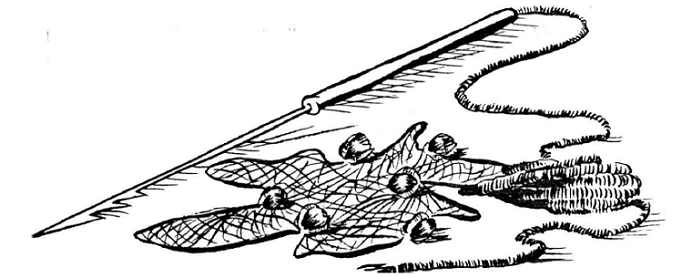
A Madlander anti-personnel rifle, probably.
Madlander society is static enough that big efforts to change the status quo will likely either fail or just backfire (GM’s will notwithstanding, apparently). Still, if your players want to do something that isn’t driven by conformity, there are a few things you can do; you know, be reformers, try going somewhere less horrible, etc. However, you CAN try to take shit over, especially if you have access to magic. The Madlands being the Madlands, you’ll probably fail, at least initially, but if you flee into the interior, you can possibly forge yourselves a bandit kingdom from outcasts and skinless. The mechanics of the setting dictate that characters that do this will probably turn into skinless themselves, but that just makes it easier: skinless are fucking badasses with extra strength, health, and supernatural bonuses. This is how you do evil campaigns.
Other settings! One sidebar presents us with advice for crossovers into other settings/types of settings. Horror is easy (throw Madlands monsters into the present, let players follow them back to their home dimension), but the book suggests crossing over with cyberpunk, of all things; it seems to imply that the Soulless would set up a virtual reality that just happens to be some cyberpunk world. Okay, sure. Other options include superhero settings – use Soulless as a brake for rising demigods – and throwing a spec ops team into the Madlands and, as a book suggests…
GURPS Fantasy II: Adventures in the Mad Lands posted:
What begins as a walkover would slowly turn into The Lost Patrol.

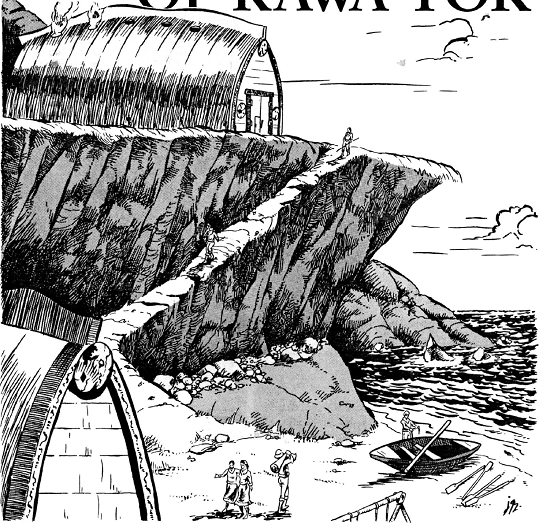
Man, all I can think of is a baboon holding up a lion cub.
Since the village is the heart of Madlander life, instead of a sample campaign, the book presents a sample village to get you started. I’m not going to bother going in depth here, because it’s a collection of biographies and that’s it. Like, there’s two paragraphs of summary and then a dozen pages explaining the personalities and behavior of people like Buvazo Bako (the elder that’s everyone’s surrogate grandma) and Akik Takivodd (the village’s sweatiest hunter), most of whom have hilarious art alongside them, but that’s par for the course for this book. Then there’s a glossary, a map, an index, and we are done!
I fucking love this book, but the more I read it, the more convinced I become that it’s borderline impossible to run a campaign in it. I mean, if your group is invested in the setting, then you’ll have an amazing time, but it sure robs the mystery if you already know how everything works. Otherwise, you have too high a bar of entry for a campaign that’s mostly about hanging with your hunter bros instead of doing anything impressive or even all that exciting. This book came out in the 90s, but I wish it’d come out maybe 20 years later as a story game, maybe a PbtA hack or one of those limited-scope games that take up no less then a dozen pages and leaves the society for the players to develop. Which defeats the point of the book
 . Either that or a series of novels – I could see them winning Hugos or something if written by the right person. But man, I really do want to fuck around in this setting and fight megaelves and organ-skeletons and politic with villagers. Oh well.
. Either that or a series of novels – I could see them winning Hugos or something if written by the right person. But man, I really do want to fuck around in this setting and fight megaelves and organ-skeletons and politic with villagers. Oh well.This book is a real treat to read. I’ve covered the bulk of its content here, but there’s still a lot hiding in here that I didn’t cover for space purposes or giving people a reason to read it themselves. This book is so out-of-print that I’m surprised its PDF hasn’t deleted itself from my computer. If you can find it, give it a read.
Hey Inklesspen? Are you still reading this thread? If so, do you remember my magnum opus? And what you said when I asked you included it in your archive for posterity?
inklesspen posted:
1: Done
2: Yes, but only if you also do a GURPS writeup for something beginning with Z (which is not Zombie). How about GURPS Zinc (emphasis mine)
3: Nom
